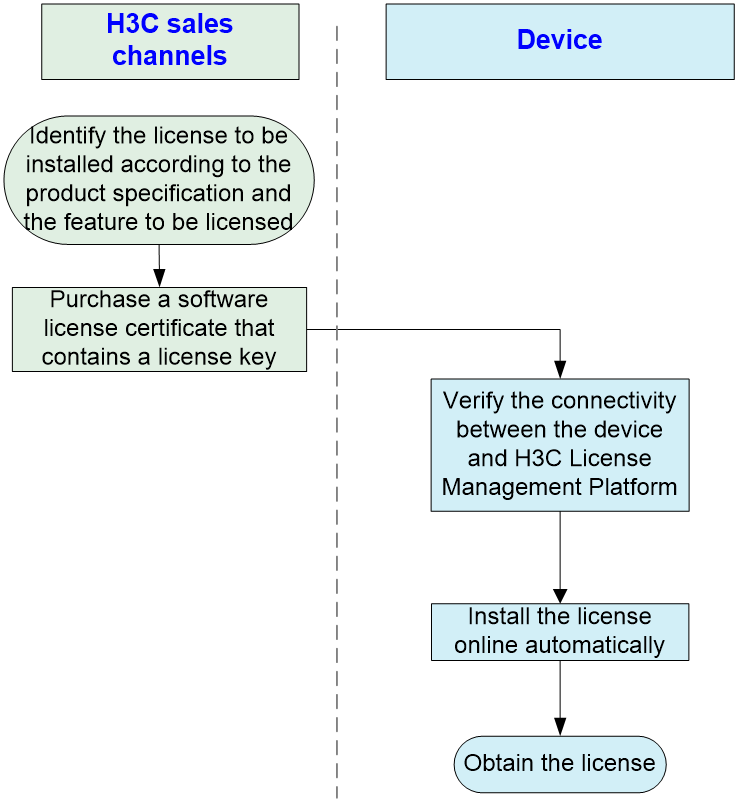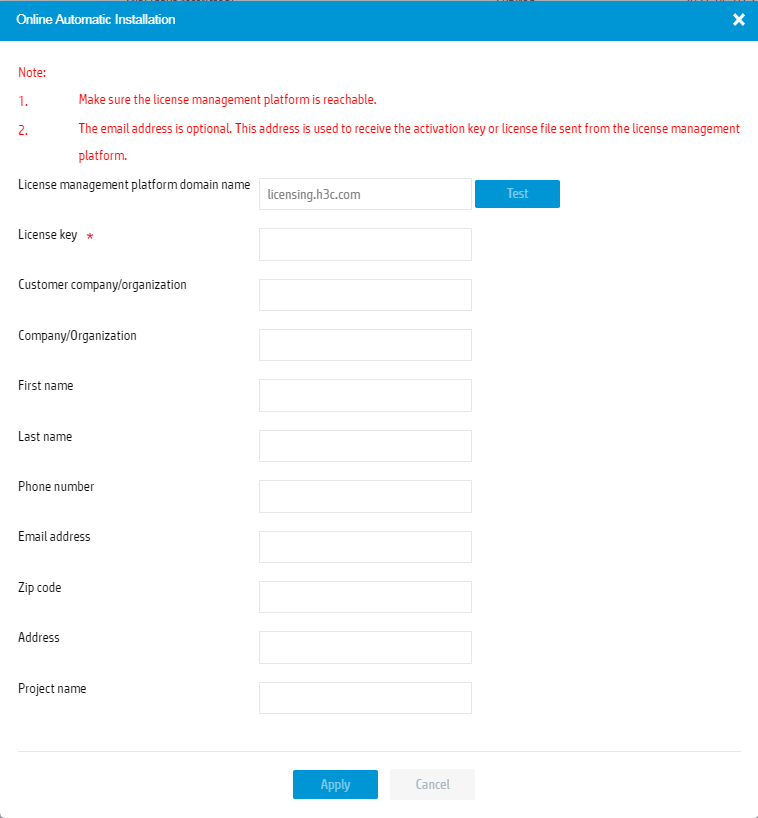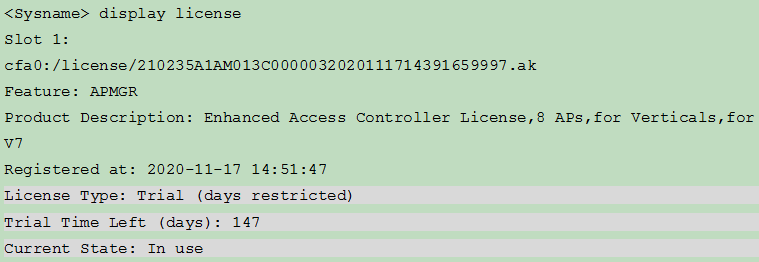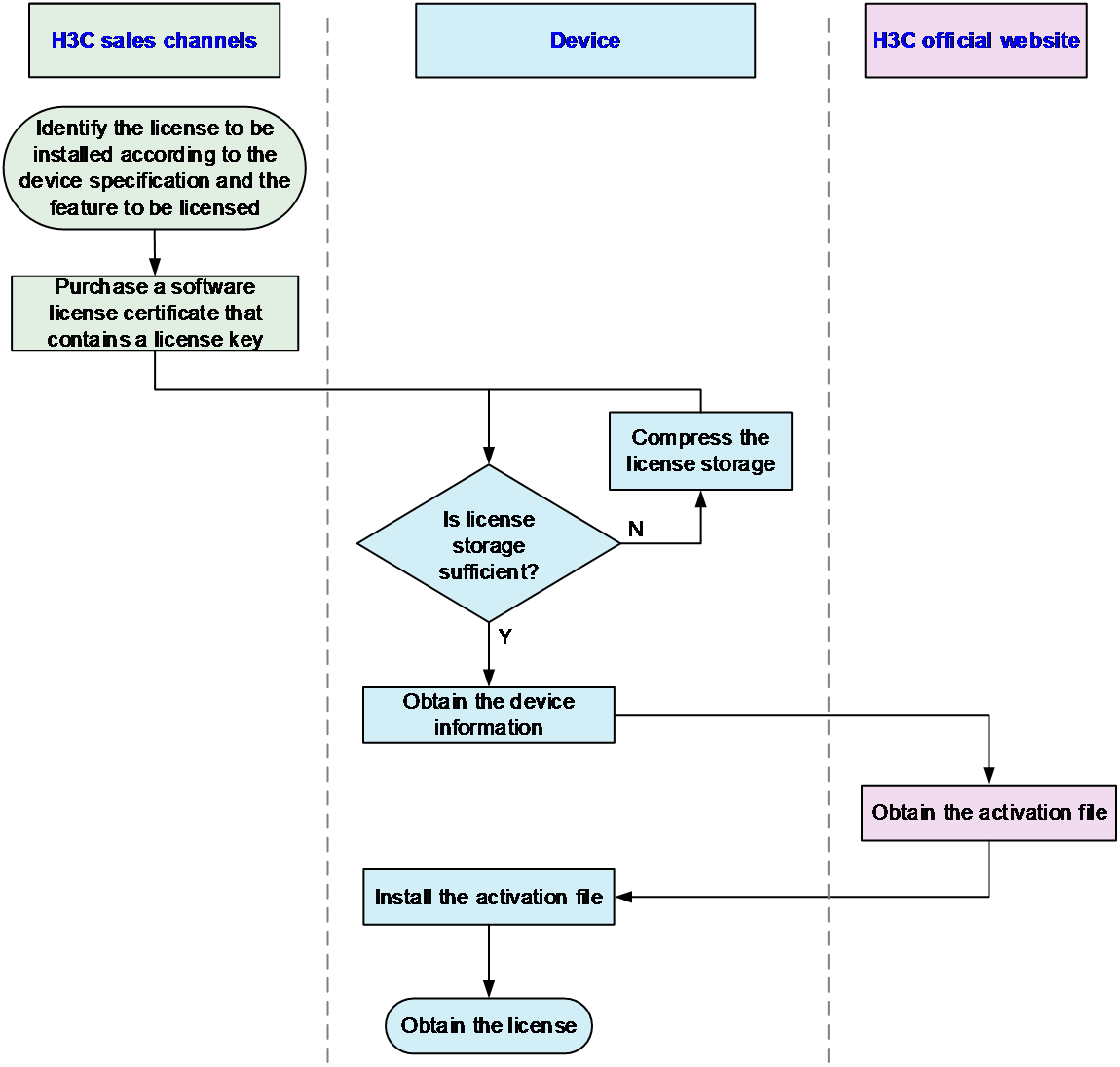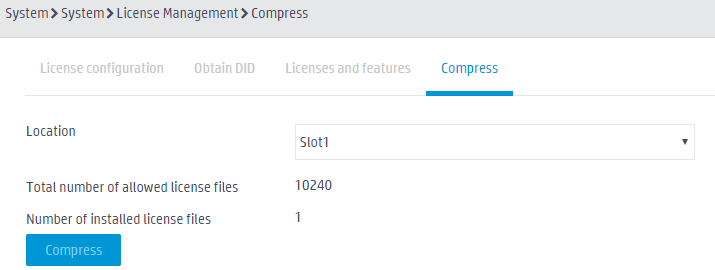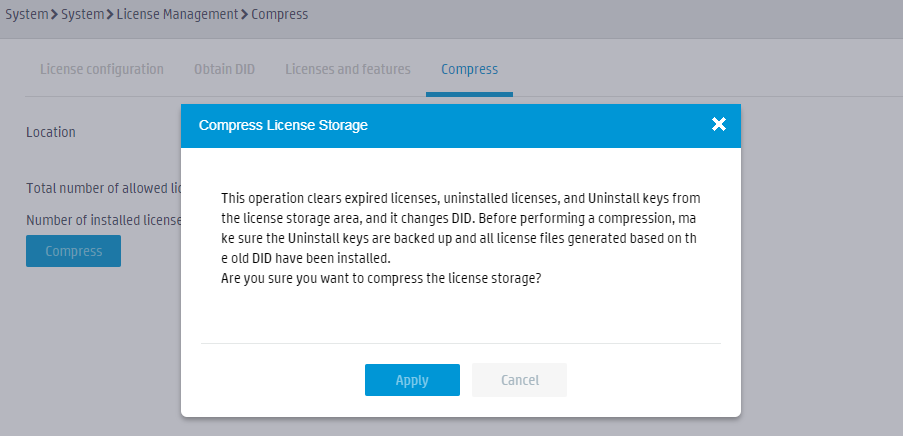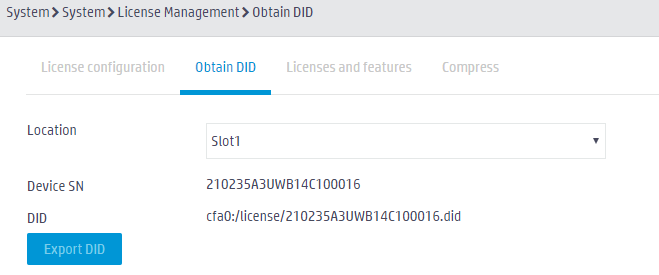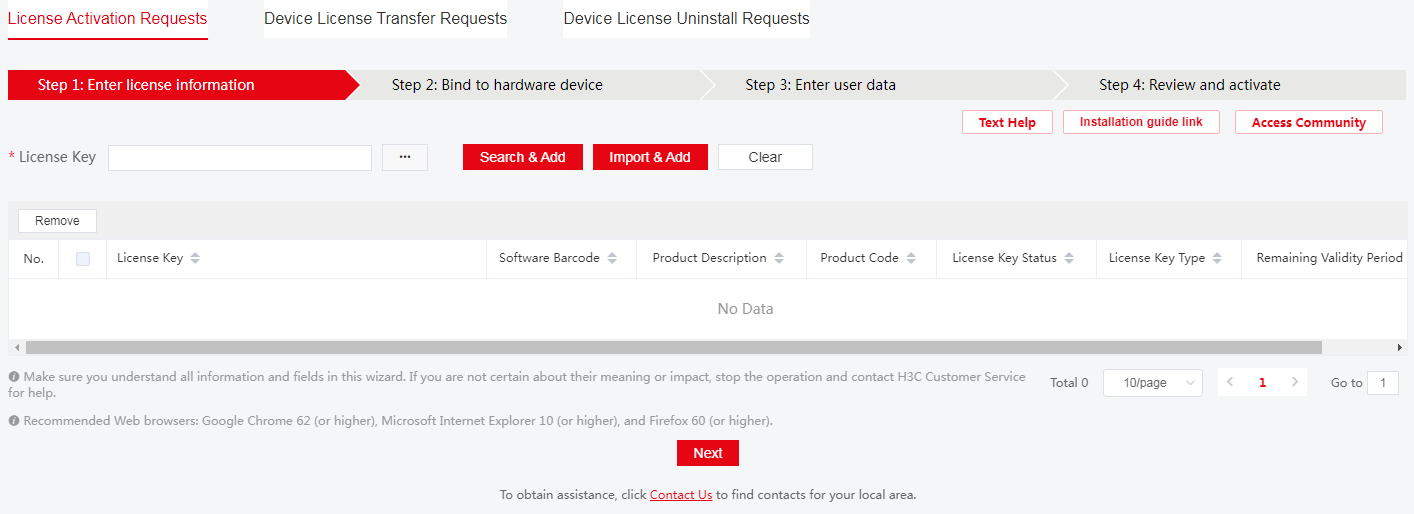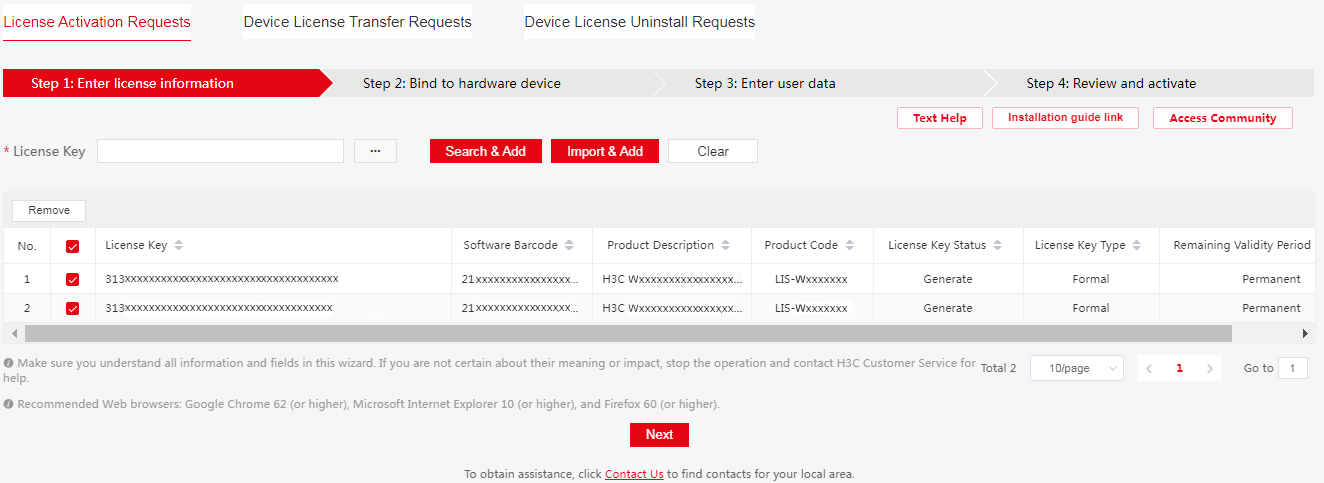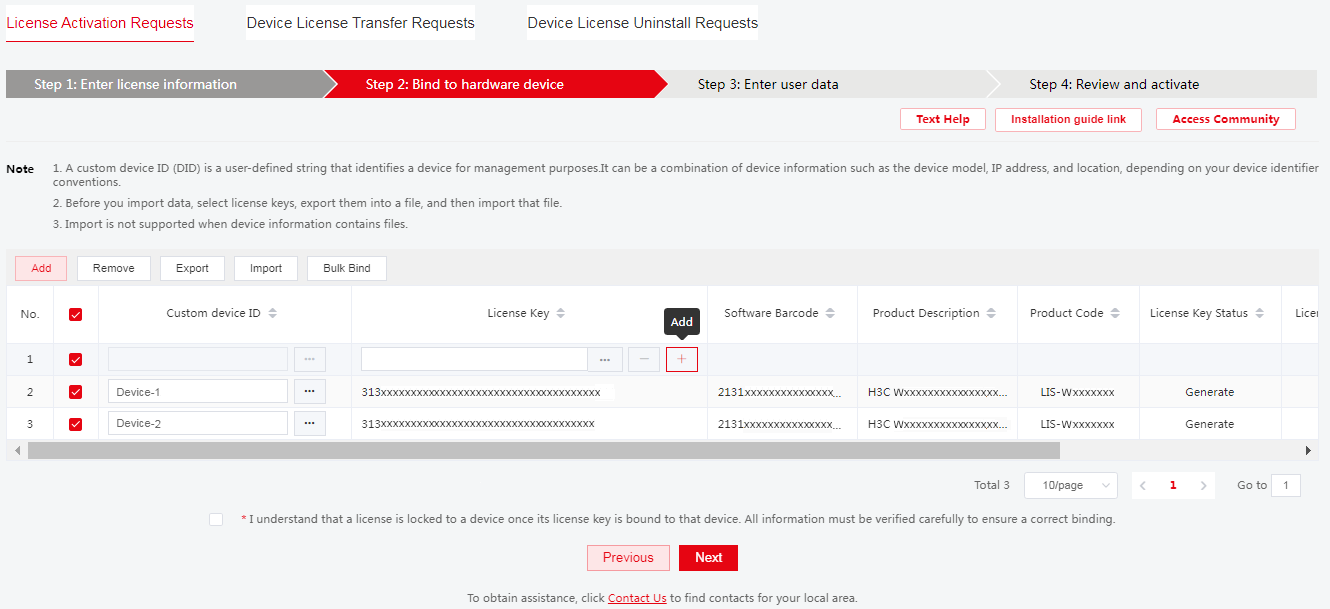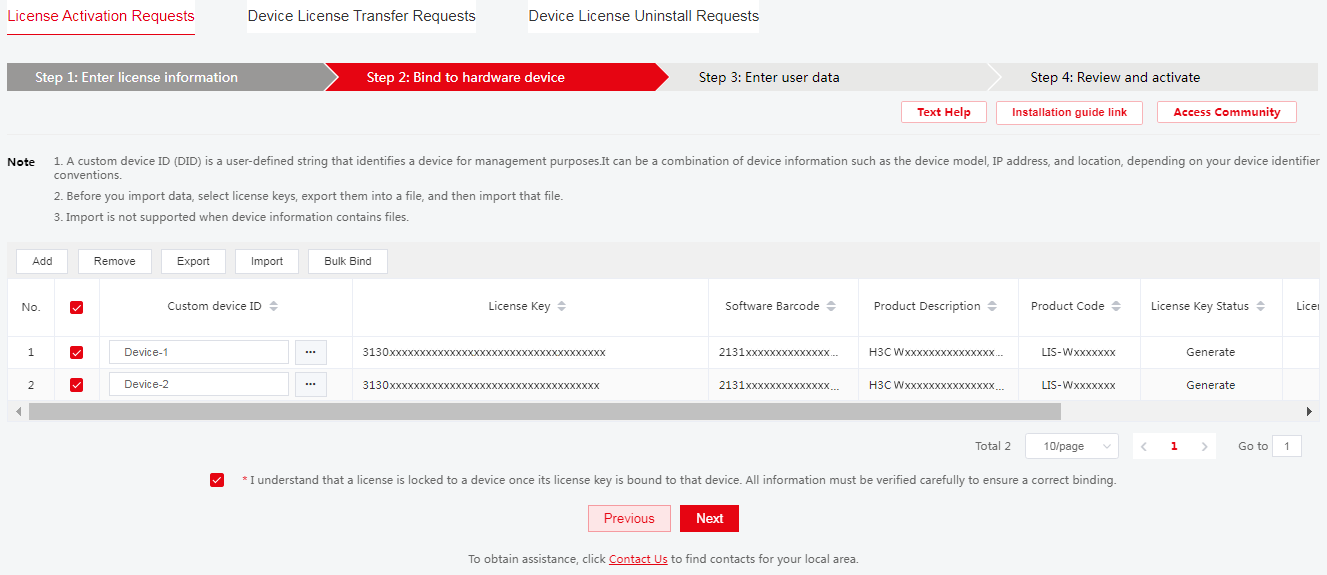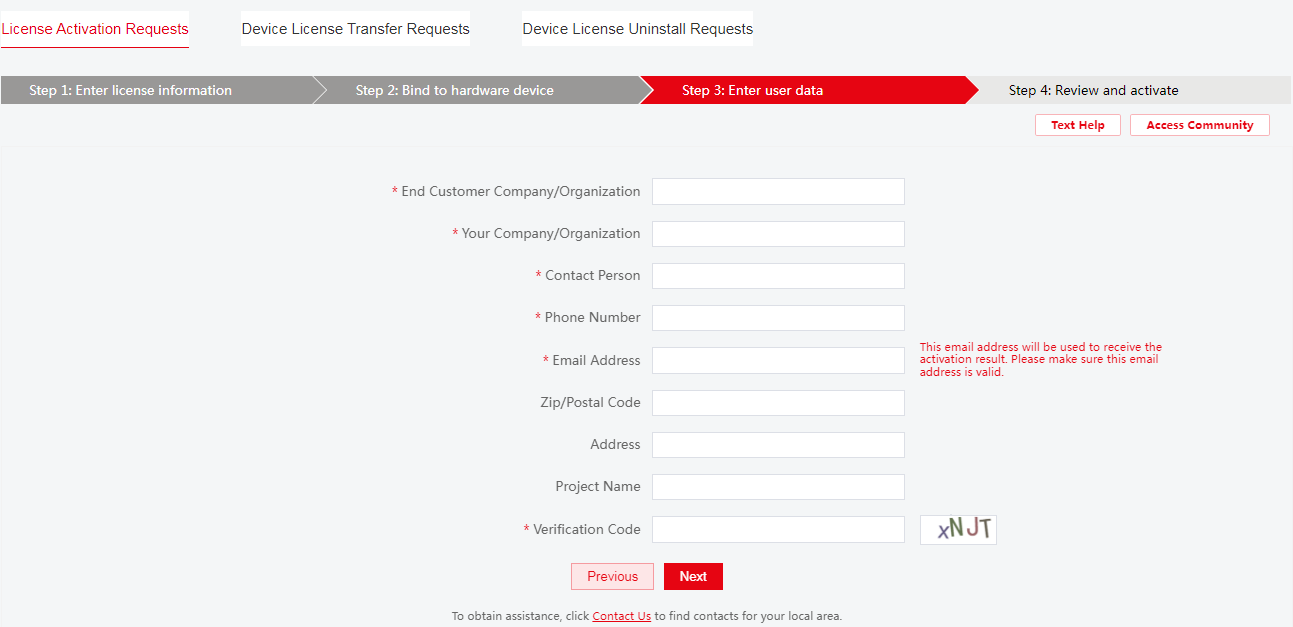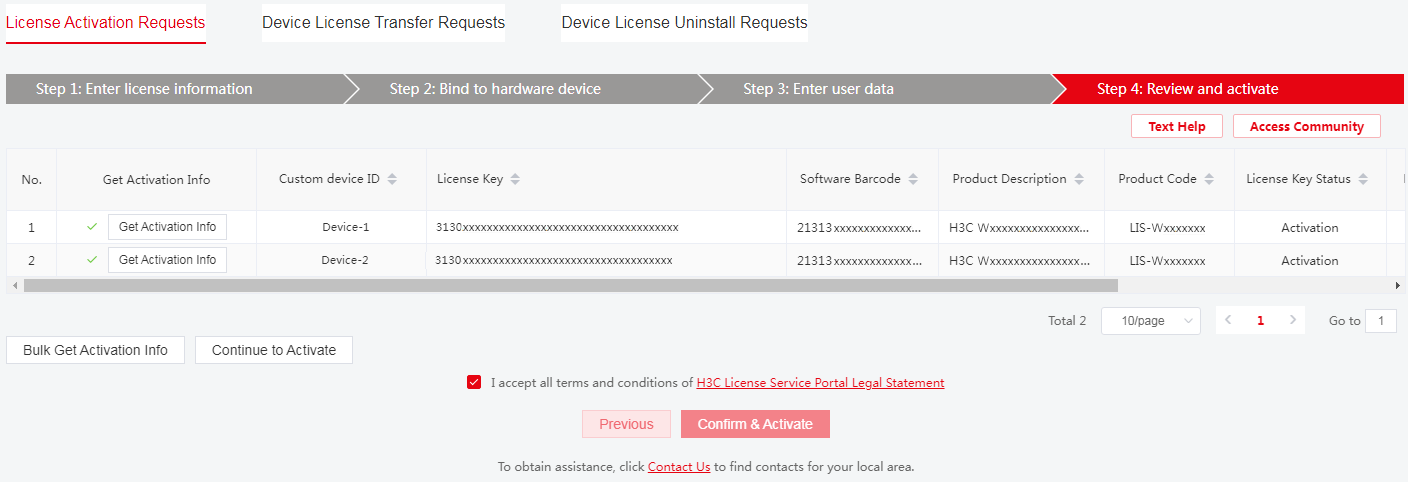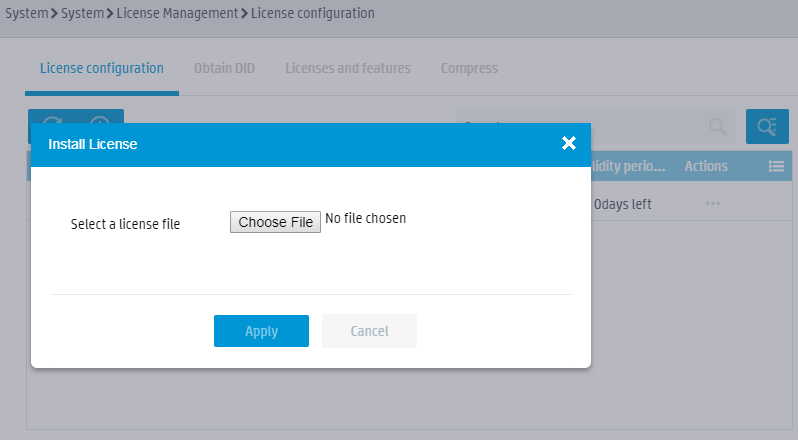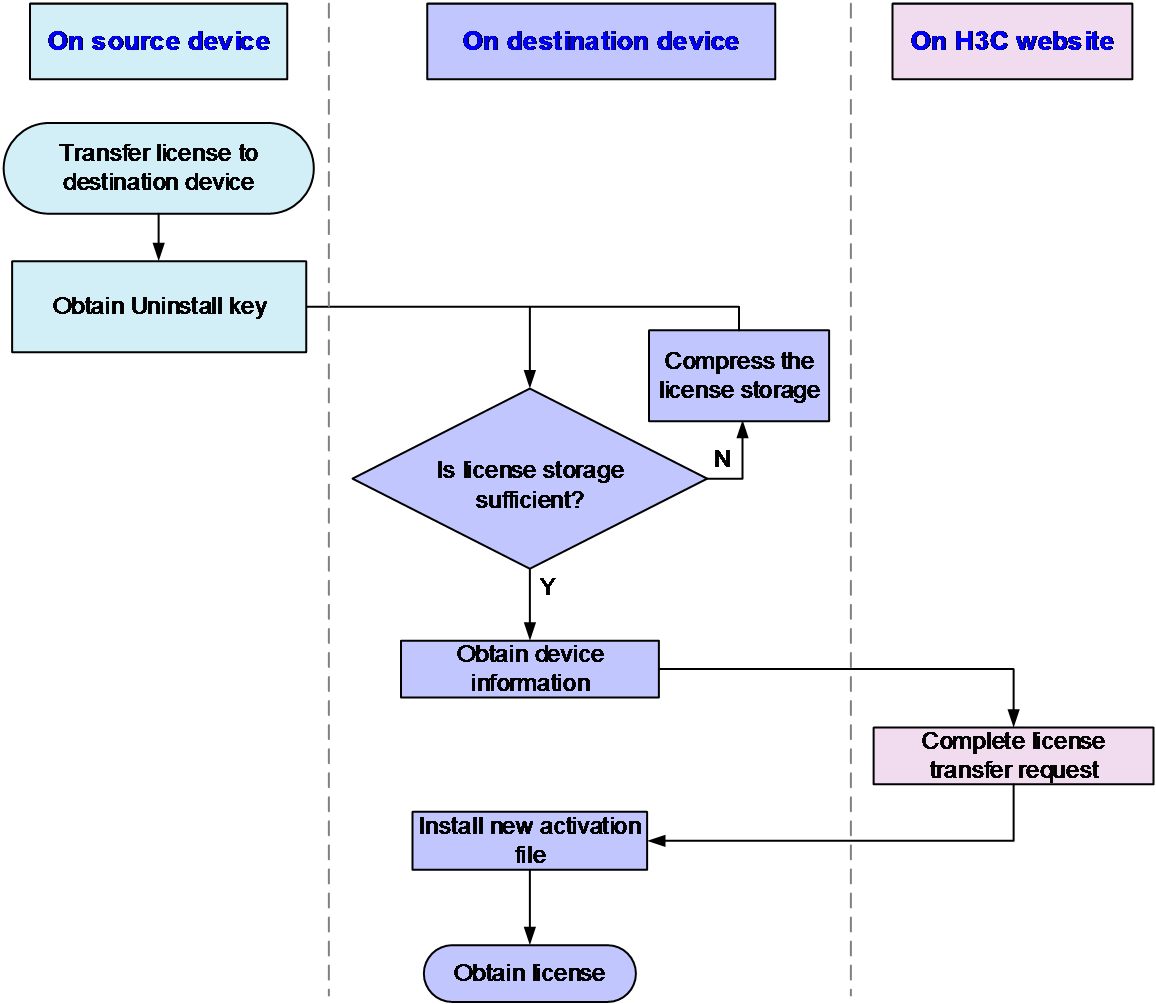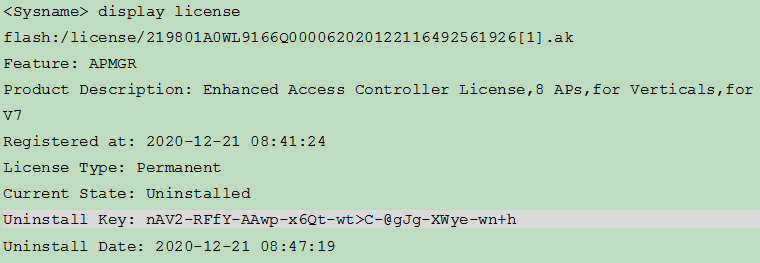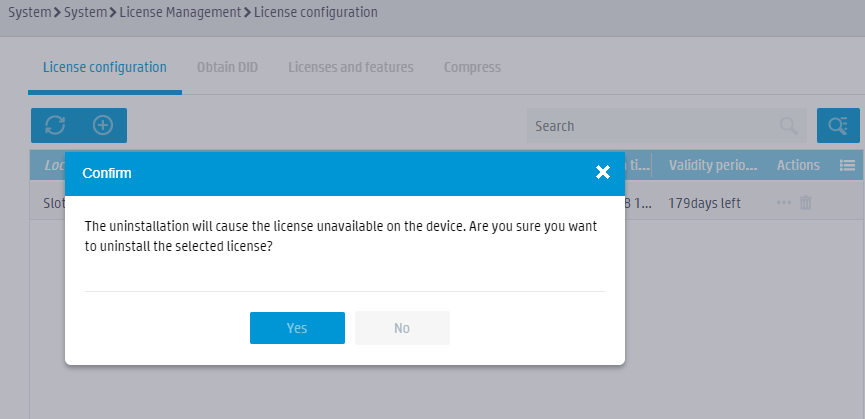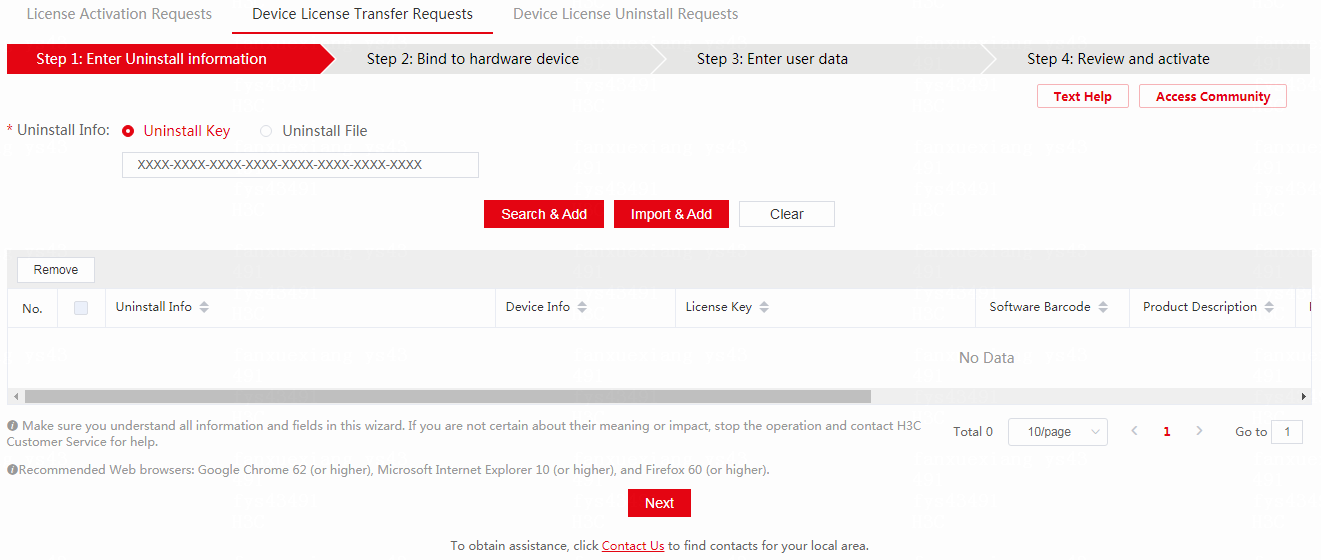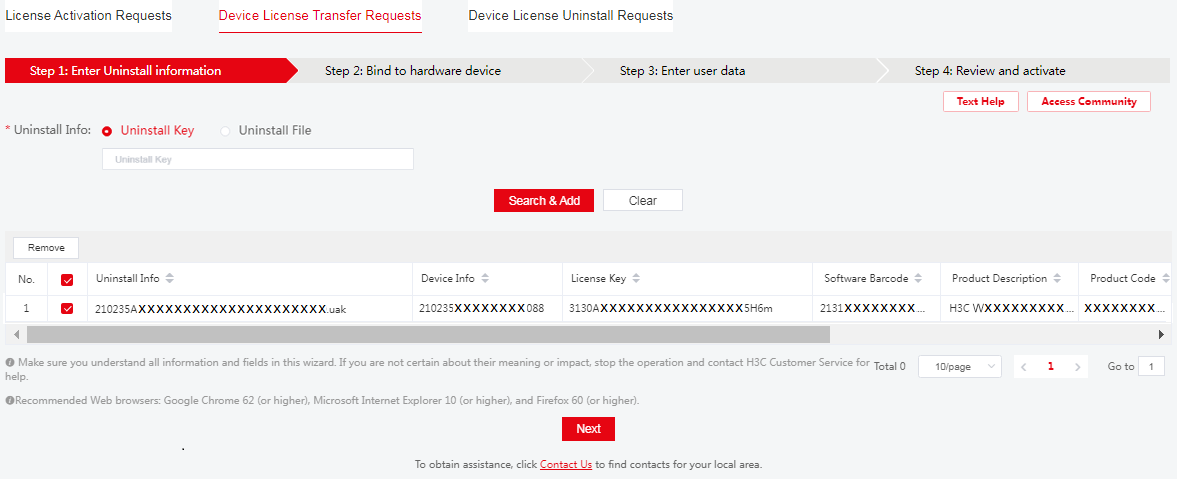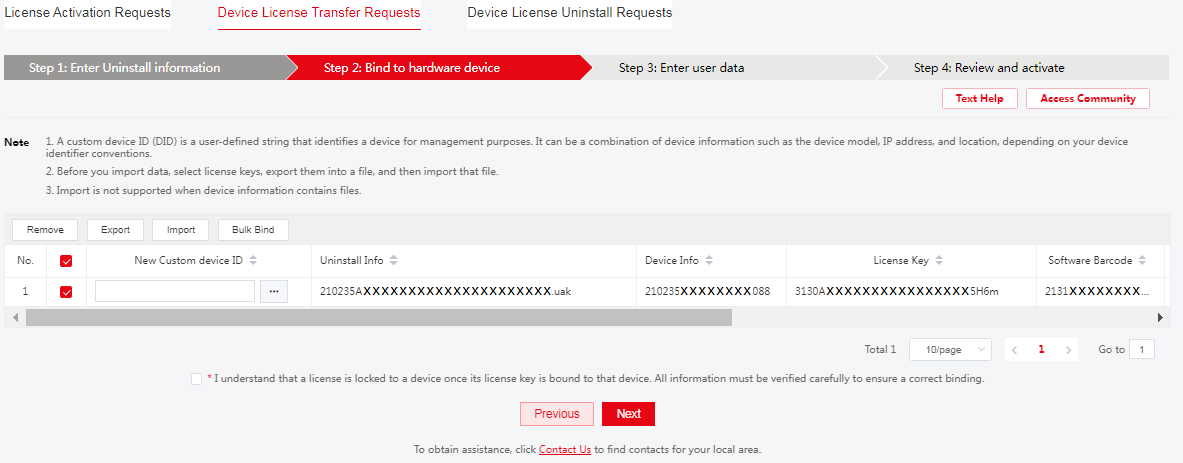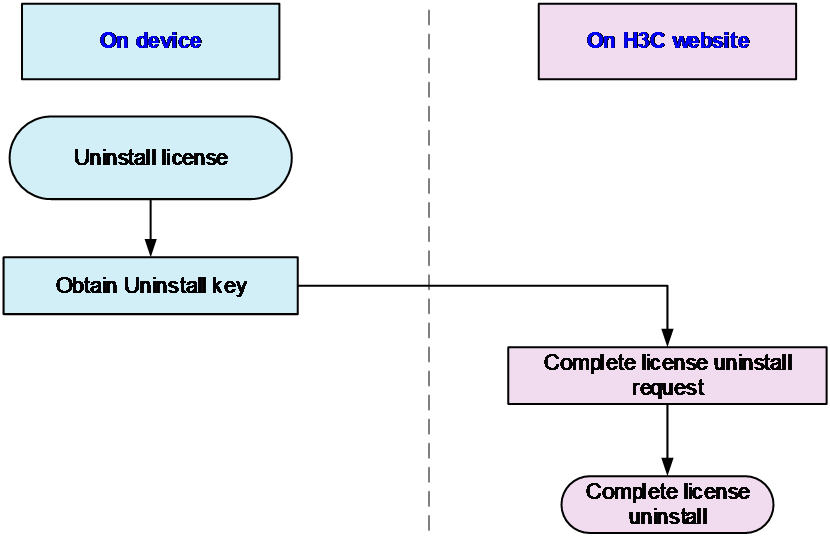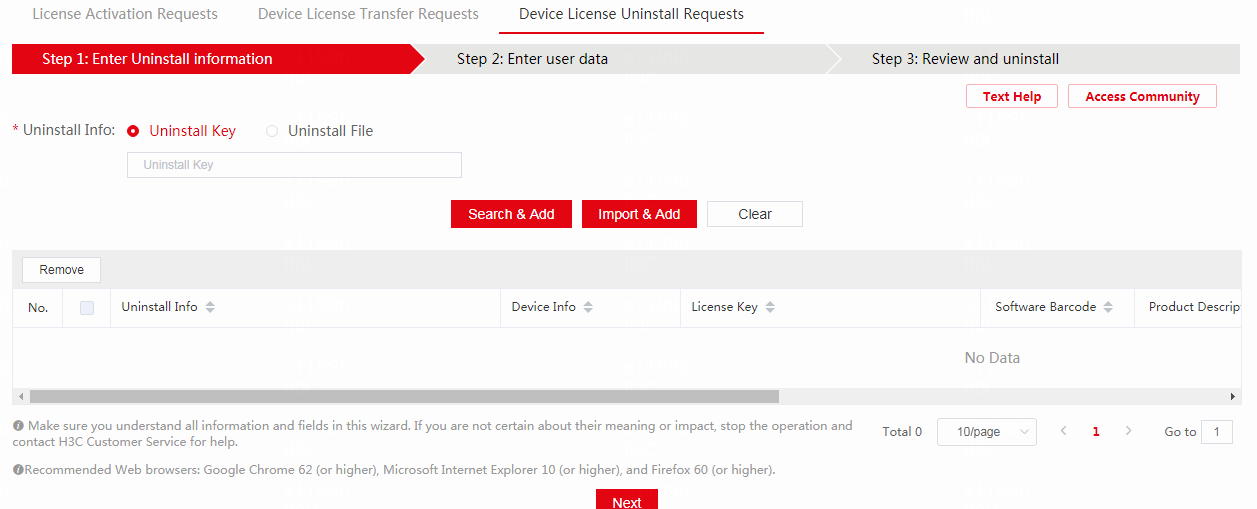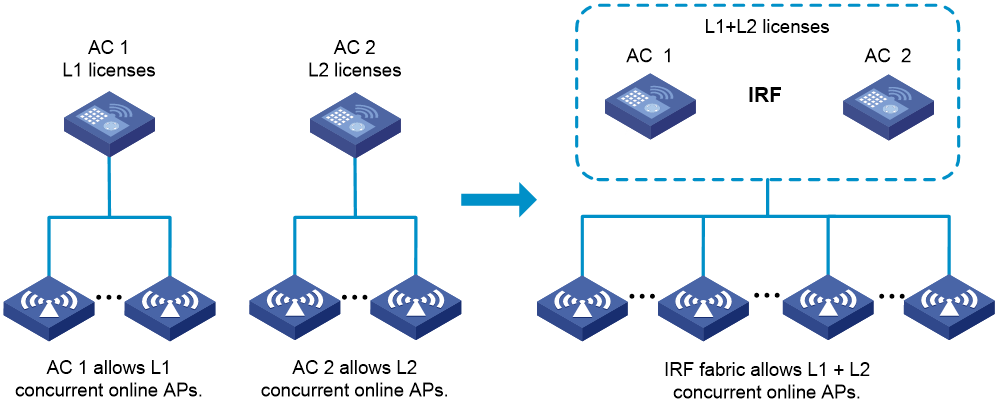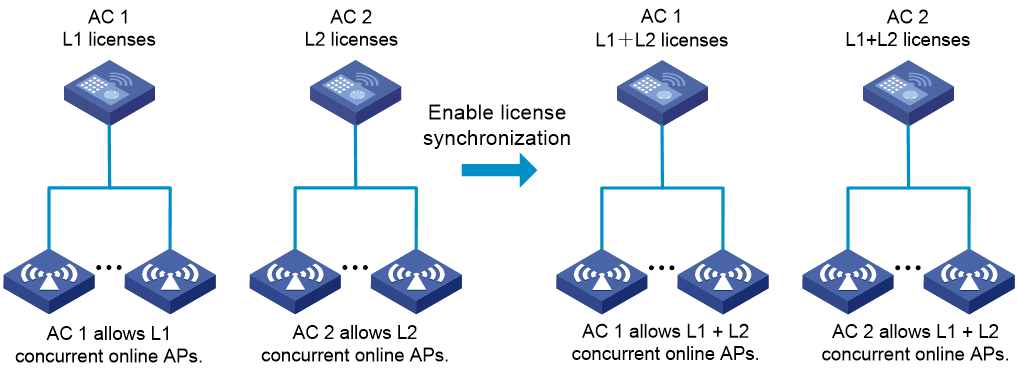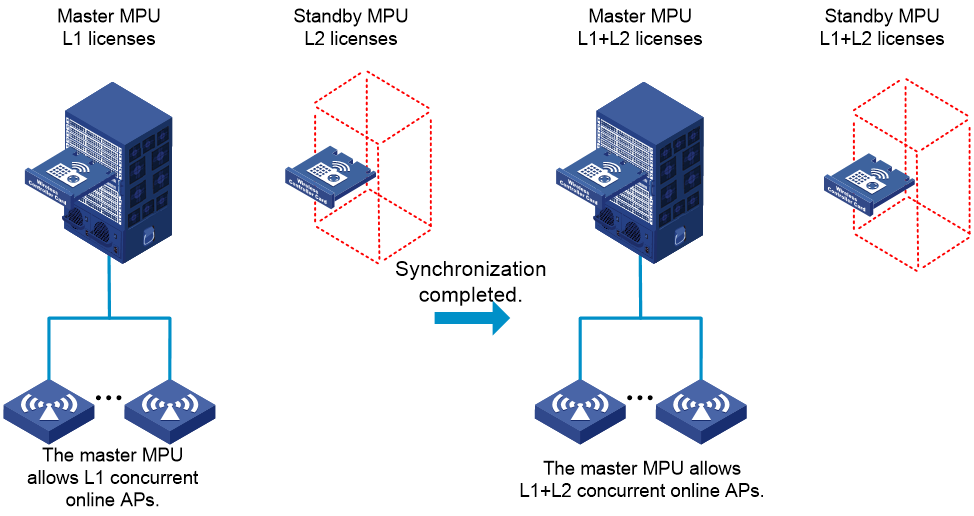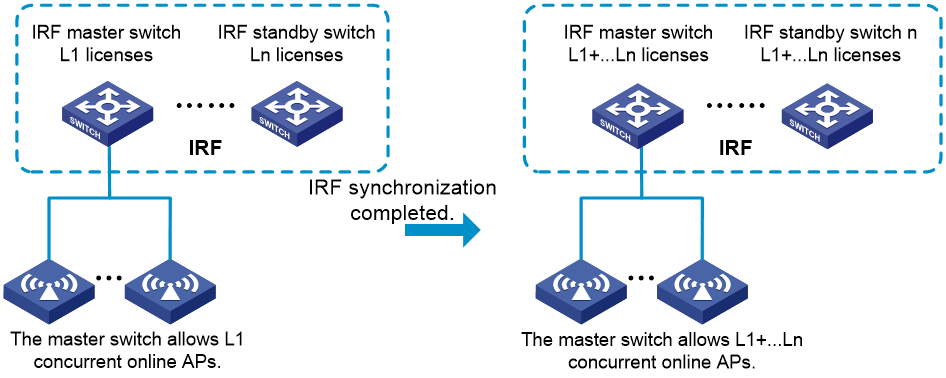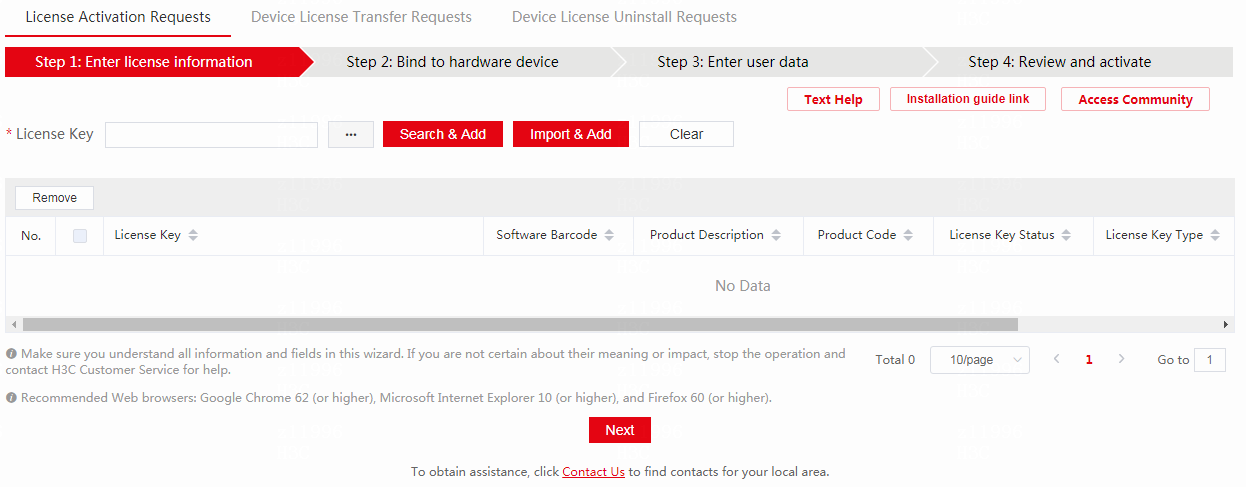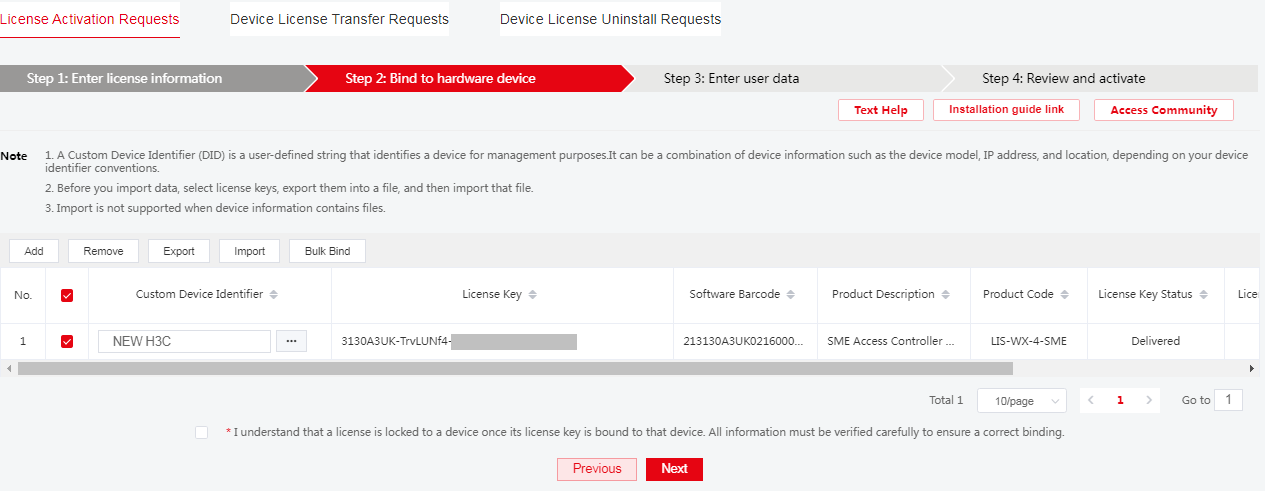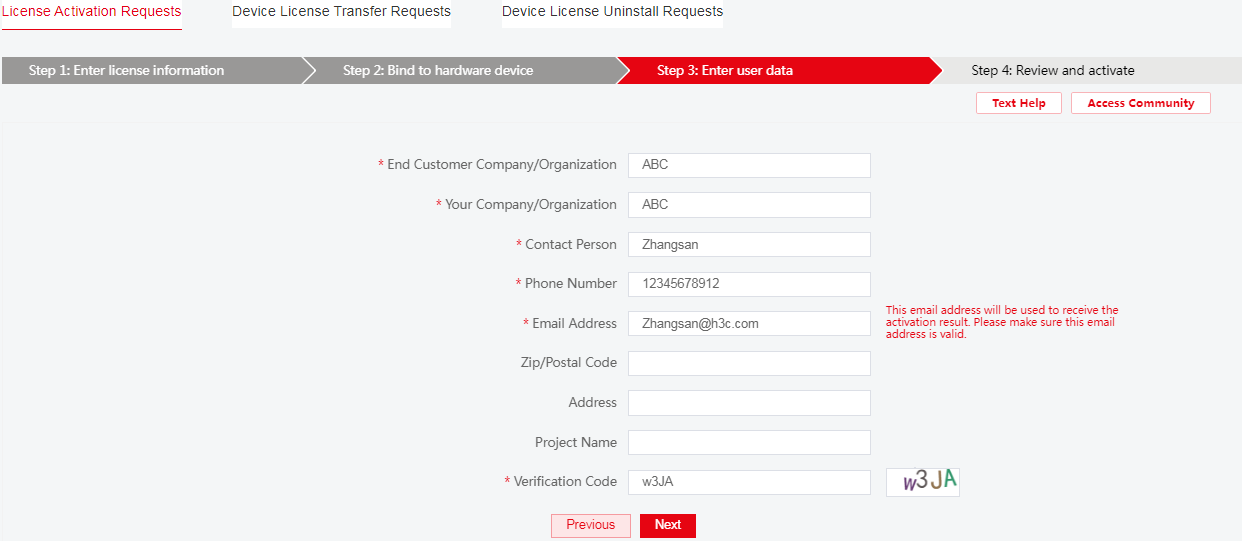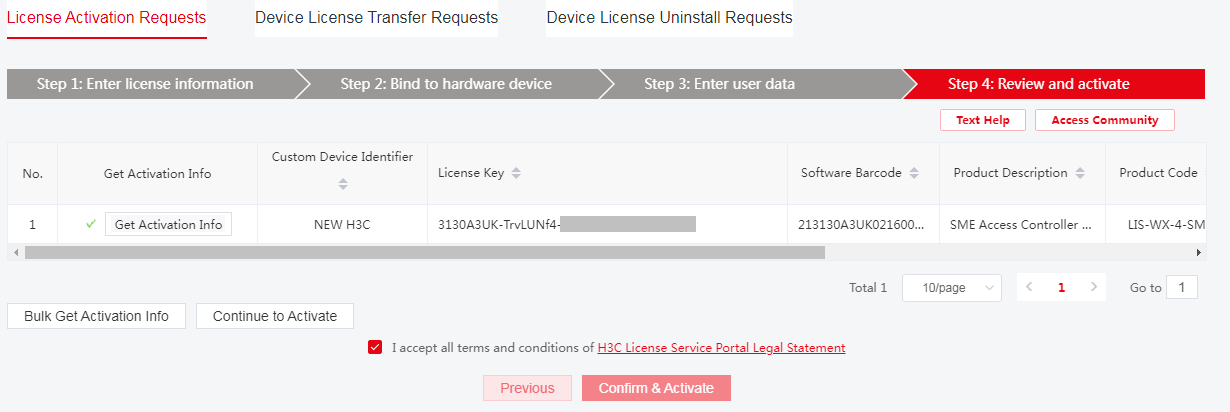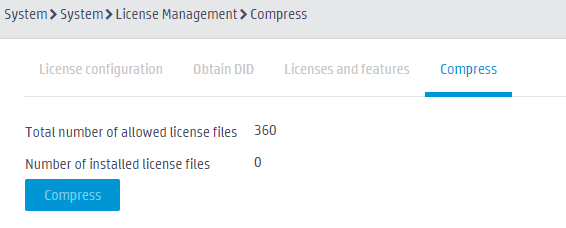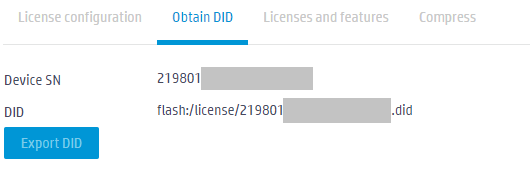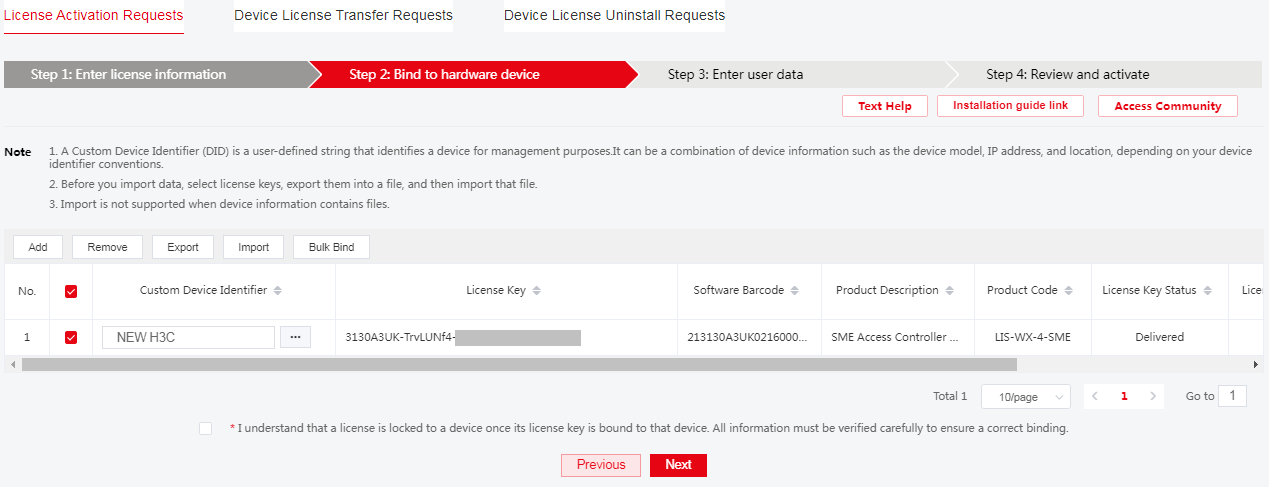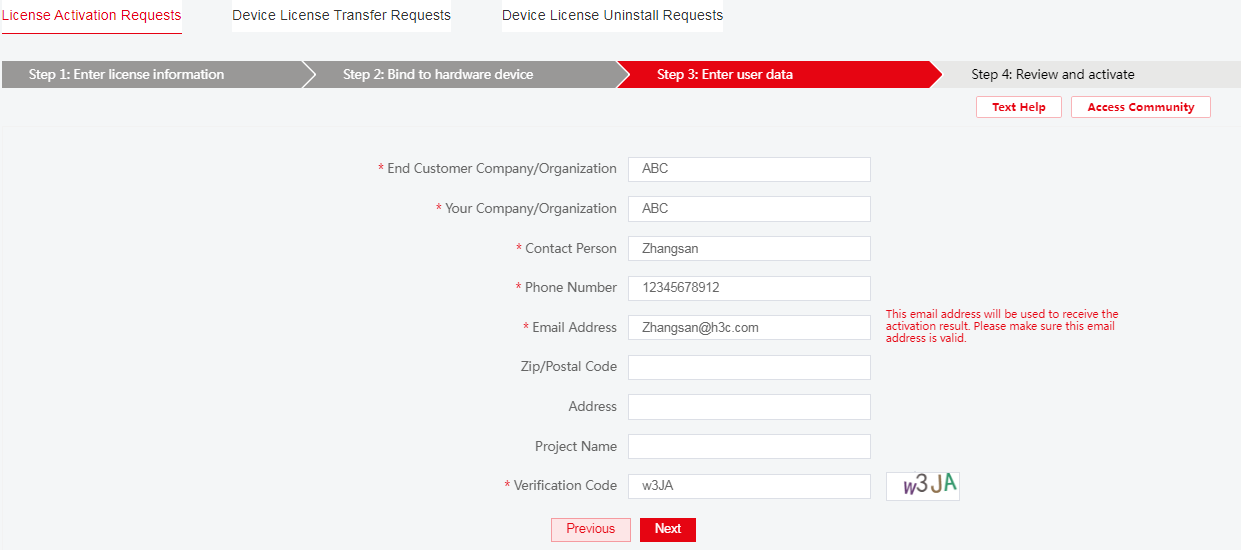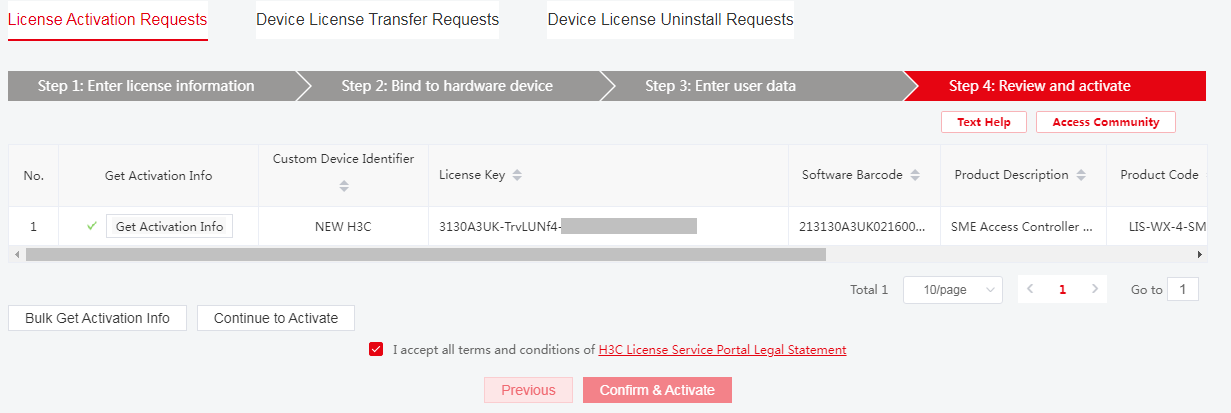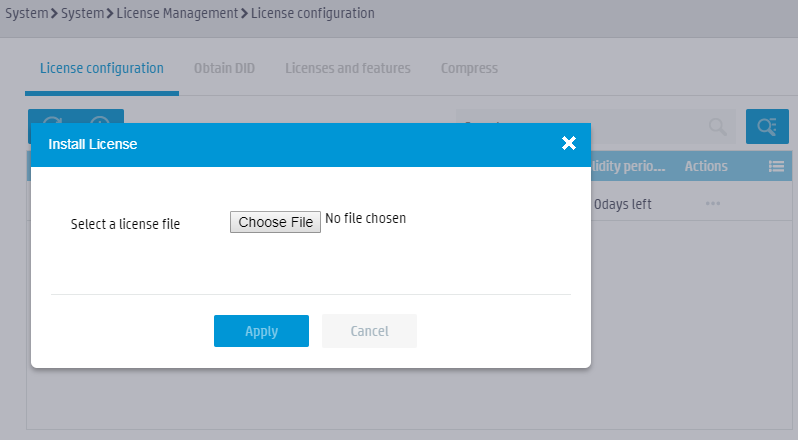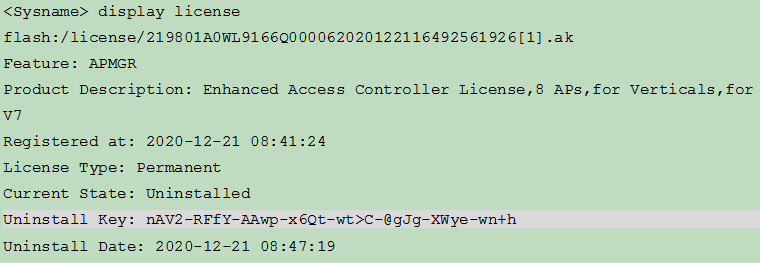- Table of Contents
- Related Documents
-
| Title | Size | Download |
|---|---|---|
| 01-H3C Comware 7 and Comware 9 WLAN Products Local Licensing Guide | 1.99 MB |
H3C Comware 7 and Comware 9 WLAN Products
Local Licensing Guide
Copyright © 2022 New H3C Technologies Co., Ltd. All rights reserved.
No part of this manual may be reproduced or transmitted in any form or by any means without prior written consent of New H3C Technologies Co., Ltd.
Except for the trademarks of New H3C Technologies Co., Ltd., any trademarks that may be mentioned in this document are the property of their respective owners.
The information in this document is subject to change without notice.
Contents
Online automatic installation for local licensing
About license online automatic installation
Management operation restrictions and guidelines
Registering and installing a license
Identifying the license storage on the device
Compressing the license storage on the device
Obtaining device information from the device
Requesting an activation file on H3C License Management Platform
Installing an activation file on the device
Obtaining an Uninstall key on the source device
Compressing the license storage of the destination device
Obtaining the device information of the destination device
Requesting license transfer on H3C License Management Platform
Installing the new activation file on the destination device
License uninstallation workflow
Obtaining an Uninstall key for a license on the device
Requesting license uninstallation on H3C License Management Platform
WLAN AP license synchronization between ACs
Distributed UWAC deployment license sharing
Appendix B License configuration examples
Requesting an activation file on H3C License Management Platform
Installing an activation file on the device
Requesting an activation file on H3C License Management Platform
Installing an activation file on the device
Q: What is a license key and what is an activation file?
Q: Can I modify the system time of the device after a license is installed?
Q: Might the DID file for the device change? What impact does a DID file change have?
Q: Can I uninstall an expired license?
Q: How do I obtain the Uninstall key for a license?
Q: Can I install an uninstalled activation file on the device again?
Q: How do I delete expired and uninstalled licenses?
Q: What should I do if I inadvertently delete the activation file for a license?
Q: How do I retrieve a lost license key?
Q: How do I retrieve an activation file?
Q: How do I transfer licenses when a node fails or when license transfer is required?
Overview
H3C offers licensing options for you to deploy features and expand resource capacity on an as needed basis. To use license-based features, you purchase licenses from H3C and install the licenses.
License types
H3C offers preinstalled, trial (or temporary), and formal licenses. Support for preinstalled and trial licenses varies by product. For more information about the license options available for a product, see the license matrixes document for that product.
Preinstalled licenses
Preinstalled licenses are built into a system and are available for use on initial startup of the system. Users do not need to activate them.
A preinstalled license is typically time limited and cannot be uninstalled or transferred.
When a preinstalled license expires, the license-based feature becomes unavailable. To continue to use the feature, you must purchase and install a formal license for it.
Trial licenses
Trial licenses are provided for you to verify the functionality of premium features so you can make an educated purchase decision.
A trial license is time limited and cannot be uninstalled or transferred.
When a trial license expires, the license-based feature becomes unavailable. To continue to use the feature, you must purchase and install a formal license for it.
To obtain a trial license for a feature:
1. Contact your H3C sales representative or technical support.
2. Register the trial license key with H3C License Management Platform to obtain an activation file.
3. Install the activation file to activate the feature.
Formal licenses
To gain most from a license-based feature, purchase a formal license for it.
Formal licenses are available with different validity periods and their support for uninstallation and transfer of formal licenses depends on product model. For more information, see the license compatibility information document for the product.
To install a formal license for a feature:
1. Purchase a software license certificate through an official channel.
2. Access H3C License Management Platform, and then enter the license key in the certificate and the required device information to obtain an activation file.
3. Install the activation file in the target system.
Concepts
The following information describes the basic concepts that you might encounter when you register, install, and manage licenses.
H3C License Management Platform
H3C License Management Platform provides product licensing services for H3C customers. You can access this system to obtain license activation file, transfer licenses, or remove the device and license binding for an uninstalled license.
H3C License Management Platform is accessible at https://new-licensing.h3c.com/website/anonymous/navIndex/en-US/activate/input-license.
Software license certificate
A software license certificate allows users to use a license-based feature. It contains license key, license capacity, and other information.
License key
A license key uniquely identifies a license.
· To obtain a formal license key, purchase a software license certificate. The authorization serial number in the software license certificate is the license key.
· To obtain a trial license key, contact your H3C sales representative or H3C technical support. Support for trial licenses depends on the device model. For more information, see the license compatibility information document for the product.
Device serial number
A device serial number (SN or S/N) is a barcode that uniquely identifies a device. It comes with the device and must be provided when you request a license in H3C License Management Platform.
Device ID (DID) and DID file
A DID is a string of characters that uniquely identifies a hardware device. A DID file stores the DID and other information. The product comes with a DID or DID file. You must provide the DID or DID file when you request a license for the device on H3C License Management Platform.
Activation file
An activation file (AF) binds a license to a system.
To use a license-based feature on a system, you must perform the following tasks:
1. Use the license key and the system’s SN information to obtain an activation file from H3C License Management Platform.
2. Install the activation file on the system.
Uninstall key and Uninstall file
When you uninstall an activation key or file, the system generates an Uninstall key (UK) or Uninstall file (UF), respectively. This information proves that the license and system binding has been removed. You must provide this information when you transfer an unexpired license from one system to another.
License storage
License storage is a persistent storage of fixed size for storing licensing information. This information includes the licensing state, licensing time, Uninstall key or file, and other related information.
Data in the license storage persists through reboot. This ensures licensing accuracy and continuity.
License sharing
License sharing enables the member devices in a multichassis system to share their licenses for a feature. For more information about license sharing, see "Appendix A License sharing."
Technical support
To obtain assistance, contact H3C by email or phone or access documents at the H3C website.
· Email:
¡ China: [email protected]
¡ Hongkong, China: [email protected]
¡ Other countries or regions: [email protected]
· Technical support hotline:
To find contacts for your local area, access the H3C global contacts page at https://www.h3c.com/en/Support/Online_Help/Service_Hotlines/
· Website: http://www.h3c.com
Online automatic installation for local licensing
About license online automatic installation
License online automatic installation simplifies license installation. You can complete license installation on the local Web interface without logging in to H3C License Management Platform.
To install a license online automatically, perform the following tasks:
1. Obtain a license key for the license.
2. Configure network settings on the device to ensure that the device can access the public network and connect to H3C License Management Platform.
3. Configure license online automatic installation on the Web interface. The device will automatically connect to H3C License Management Platform in the background to request an activation file and install the activation file on the device.
Restrictions and guidelines
· License online automatic installation is supported only on the Web interface in expert mode.
· Support for license online automatic installation depends on the device model. To identify whether the device supports this feature, log in to the Web interface of the device in expert mode and go to the System > System > License Management > License configuration page. If you can select online automatic installation or local manual installation, the device supports license online automatic installation.
· Make sure the device can access the public network and connect to H3C License Management Platform. If the device acts as a gateway or acts as an AC in hairpin mode, it obtains an IP address through DHCP by default. You can configure PPPoE, static IP address, and static routing to ensure that the device can access the public network through the upstream network.
Installing a license
Installation workflow
The procedures for installing formal licenses and trial licenses are the same except the channels to obtain license keys. Figure 1 shows the workflow to install a license online automatically.
Figure 1 License installation workflow
Obtaining a license key
|
CAUTION: After you obtain a license key, back it up and keep the backup license key in a safe place for future use. For some device models, you must make sure the number of AP licenses installed on a device does not exceed the number of AP license allowed on the device to ensure successful license installation. MSG series multiservice gateways and WAC and MAK series access controllers are examples of such device models. |
Obtaining a formal license key
1. Log in to the Web interface of the device, click the system view tab at the bottom of the page, and then select System > License Management from the left navigation pane. On the Licenses and features tab, identify features that require licensing.
Figure 2 Sample from the Web interface
2. To use a license-based feature, purchase a software license certificate for it. The authorization serial number in the software license certificate is the license key.
Obtaining a trial license key
If you need a trial license key to verify the functionality of a feature before you making a purchase decision, contact your H3C sales representative or H3C Support.
Installing a license
1. Log in to the Web interface of the device.
2. Click the system view tab at the bottom of the page.
3. From the left navigation pane, select System > License Management.
4. On the License configuration tab, click Online Automatic Installation.
Figure 3 License configuration
5. In the dialog box that opens, click Test to verify the connectivity between the device and H3C License Management Platform. If they cannot reach each other, resolve the issue.
6. Enter license key and user information, and then click Apply.
Figure 4 License online automatic installation
7. On the License configuration page, you can view license information.
Figure 5 Viewing license information
Local licensing
|
IMPORTANT: The command output in this document is for illustration only. The actual command output varies by device model. |
About local licensing
Local licensing requires license activation device by device. It is applicable to small-sized networks.
To install a license on a device:
1. Obtain the license key and the SN of the device.
2. Access H3C License Management Platform to request an activation file based on the license key and the device's SN.
3. Install the activation file on the device to activate the license.
The activation file for a license is device locked. You cannot install the activation file for one device to activate the license on another device.
Figure 6 Local licensing procedure
Restrictions and guidelines
Management operation restrictions and guidelines
· Purchase licenses from H3C authorized channels.
· To identify the validity periods of the licenses that have been installed on the device, execute the display license command or do that from the Web interface. If the license for a feature is time limited, install a new license for the feature before the old license expires.
Figure 7 Sample output from the display license command
Figure 8 Sample from the Web interface
· Licenses are typically device locked. To ensure a successful licensing, use the following licensing guidelines:
a. When you purchase a license certificate, verify the following items:
- Make sure the license is compatible with the target device.
- Make sure its licensed functionality and capacity meet your requirements.
b. When you obtain an activation file, make sure the provided license key and hardware information are correct.
c. Install the activation file on the correct target device.
· Make sure no one else is performing license management tasks while you are managing licenses on the device.
· Unless otherwise stated, all character strings entered on H3C License Management Platform are case sensitive. As a best practice to ensure a successful licensing, copy and paste license keys, device SNs, and values for other critical fields as long as possible.
File operation restrictions
When you operate DID files or activation files, follow these restrictions and guidelines:
· To avoid licensing error, do not modify the file name or edit the file content.
· Before you install an activation file, download the activation file to the storage media of the device such as flash memory. When installing an activation file, the device automatically copies the activation file to the license folder in the root directory of the storage media. The license folder stores important files for licensing. For licensed features to function correctly, do not delete or modify the license folder or the files in this folder.
Registering and installing a license
The procedures for registering and installing formal licenses and trial licenses are the same.
Figure 9 shows the licensing procedure.
Licensing requirements
Single-node deployment
Licenses for fixed-port devices are device locked (also called chassis locked). You purchase, register, and install licenses on a per-device basis.
Licenses for access controller modules are module locked. You purchase, register, and install licenses on a per-module basis. If you remove an access controller module from Device A and then install it on Device B of the same series, the licensed features on Device A do not take effect and the licensed features on Device B can operate correctly before the licenses expire.
Licenses for unified wired and wireless modular devices are device locked or MPU locked, depending on the device series. To identify the license locking type, execute the display license feature command.
· If the command output does not contain slot fields, the license is device locked. Use the following guidelines:
¡ You purchase licenses and install their activation files on a per-device basis.
¡ When you install an activation file, the system automatically copies the activation file to all MPUs of the device.
- The licensed feature can operate correctly after you remove one of the MPUs.
- If you replace one of the MPUs, the system automatically copies all activation files to the new MPU to make sure the licensed features can operate correctly after an active/standby switchover.
- If you are replacing both MPUs at the same time, back up the activation files. After the replacement, you must copy the activation files back to the new active MPU for the licensed features to continue to take effect. The system will automatically copy the activation files to the standby MPU.
Figure 10 Command output without the slot field
· If the command output contains slot fields, in Slot xx or Chassis xx Slot xx format, the licenses are MPU locked. Use the following guidelines:
¡ You purchase, register, and activate licenses of the same specifications for each MPU in the device. This ensures that the license-based features can continue to take effect after an active/standby switchover.
¡ If you move the MPUs to another device, the license-based features can continue to take effect on the destination device as long as they are still valid. To have the license-based features continue to take effect on the source device, you must purchase, register, and activate new licenses for the new MPUs.
Figure 11 Command output with slot fields
1+N node redundancy deployment
In a 1+N node redundancy deployment, only the licenses installed on the current master node are used if the deployment does not support license sharing. For a license-based feature to take effect after a master/standby switchover, you must purchase, register, and install a license of the same specification on each of the member node. The license installation requirements and license installation procedures are the same across the member devices. If the deployment supports license sharing, see "Appendix A License sharing."
Obtaining a license key
After you obtain a license key, back up it and keep the backup license key in a safe place for future use. For some device models, you must make sure the number of AP licenses installed on a device does not exceed the number of AP license allowed on the device to ensure successful license installation.
Obtaining a formal license key
1. Obtain a formal license key from the CLI or Web interface:
a. Log in to the CLI of the device and execute the display license feature command in any view to identify features that require licensing.
Figure 12 Sample output from the display license feature command
b. Log in to the Web interface of the device, click the system view tab at the bottom of the page, and then select System > License Management > Licenses and features from the left navigation pane to identify features that require licensing.
Figure 13 Sample from the Web interface
2. To use a license-based feature, purchase a software license certificate for it. The authorization serial number in the software license certificate is the license key.
Obtaining a trial license key
If you need a trial license key to verify the functionality of a feature before you making a purchase decision, contact your H3C sales representative or H3C Support.
Identifying the license storage on the device
To identify the free space of the license storage, access the CLI or Web interface of the device.
· From the CLI, execute the display license feature command in any view.
From the command output, view the Total and Usage fields to examine whether the remaining license storage is sufficient for installing new licenses. If the remaining license storage is not sufficient, compress the license storage.
Figure 14 Identifying the license storage
· From the Web interface, click the system view tab at the bottom of the page, select System > License Management from the left navigation pane, and then click the Compress tab to identify the license storage.
Figure 15 Identifying the license storage
Compressing the license storage on the device
About this task
The license storage stores licensing information and has a fixed size.
You compress the license storage to delete expired and uninstalled license information to ensure sufficient storage space before applying for an activation file.
If no license has been installed on the device, you do not need to compress the license storage.
Restrictions and guidelines
Back up the Uninstall keys for the uninstalled licenses for subsequent license transfer or license uninstallation on H3C License Management Platform.
If uninstalled licenses or expired licenses exist on the device, the compression operation will make the DID change. You will be unable to install the activation key or activation file obtained by using the old DID on the device. As a best practice, install all activation files registered with the old DID before performing a compression.
If you have not installed an activation file registered with the old DID, take the following actions:
· If the license storage is sufficient, install the activation file on the device. For more information, see "Installing an activation file on the device."
· If the license storage is insufficient and the activation file cannot be installed after the compression, contact H3C Support.
Procedure (from the CLI)
1. Execute the system-view command to enter system view.
2. Execute the license compress command to compress the license storage.
Procedure (from the Web interface)
1. Click the system view tab at the bottom of the page.
2. From the left navigation pane, select System > License Management, click the Compress tab, click Compress, and then click OK in the dialog box that opens.
Figure 16 Compressing the license storage
Obtaining device information from the device
Device information is required for license registration on H3C License Management Platform.
CLI
Log in to the CLI of a device and obtain the following parameters:
· H3C device SN—You can execute the display device serial-number command in any view to obtain the value of the SN field.
· DID or DID file—You can execute the display license device-id command in any view to obtain the value of the Device ID field. Use FTP or TFTP to upload the DID file to the PC. If FTP is used to transfer the DID file, use the Binary mode.
Figure 17 Obtaining the DID file
The values for the fields depend on the device model.
Web interface
1. Click the system view tab at the bottom of the page.
2. From the left navigation pane, select System > License Management, click the Obtain DID tab, and then click Export DID.
Figure 18 Obtaining device information
Requesting an activation file on H3C License Management Platform
About this task
On H3C License Management Platform, you can use one of the following methods to request an activation file:
· Bind one license key to one device in one request.
· Bind multiple license keys to one device or multiple devices in one request.
Adding license keys
1. Open a Web browser and access H3C License Management Platform at https://new-licensing.h3c.com/website/anonymous/navIndex/en-US/activate/input-license.
|
IMPORTANT: As a best practice, use Chrome 62 or above, IE 10 or above, or Firefox 60 or above. |
2. Access the License Activation Requests page as shown in Figure 19.
Figure 19 License Activation Requests page
3. Use one of the following methods to add license keys:
¡ To add license keys one by one:
# Enter or copy and paste a complete license key in the empty License Key box as shown in Figure 19, and then click Search & Add. The platform will automatically obtain the information associated with the license key.
# Repeat this step to add multiple license keys.
¡ To add license keys by uploading the QR code images for the license keys:
# Click the ![]() icon next to the License Key box as shown in Figure 19,
and then upload the QR code image for a license key as shown in Figure 20.
icon next to the License Key box as shown in Figure 19,
and then upload the QR code image for a license key as shown in Figure 20.
# Click Search & Add in Figure 19. The platform will automatically obtain the information associated with the QR code image.
# Repeat this step to add multiple license keys.
|
IMPORTANT: Make sure the uploaded image is complete and clear for the platform to correctly recognize it. |
Figure 20 Uploading the QR code image for a license key
¡ To add license keys in bulk.
# As shown in Figure 19, click Import & Add.
# In the dialog box that opens, click the Download Excel License Key Import Template link to download the Excel license key import template, as shown in Figure 21. The contents in the template are as shown in Figure 22.
# Enter license keys in the template, save the template, and then upload it to the platform. The license keys in the template are all imported to the platform.
Figure 22 Contents in the Excel license key import template
4. Select license keys to be activated, and then click Next, as shown in Figure 23.
Figure 23 Finishing adding license keys
Binding license keys to devices
1. Verify that the license keys to be activated are all added.
¡ To add a license key on the page as shown in Figure 24:
- Click Add.
- Enter or copy and paste a complete license key in the License Key column, or click the ![]() icon in the column to upload the QR code image for a license key.
icon in the column to upload the QR code image for a license key.
- Click the plus icon (+) to add the license key.
¡ To remove a license key, select that license key, and then click Remove.
Figure 24 Adding or removing license keys
2. Enter device information as instructed by H3C License Management Platform:
To obtain device information, use the method as described in "Obtaining device information from the device."
Use one of the following methods to bind license keys to devices:
¡ To bind one license key to one device:
# Click the ![]() icon next to the Custom device ID box
in the license key entry, as shown in Figure 24.
icon next to the Custom device ID box
in the license key entry, as shown in Figure 24.
# In the dialog box that opens, set the device ID and upload the device information file of the device as instructed, and then click Yes.
Figure 25 Entering device information
# Repeat the steps to bind multiple license keys to different devices.
¡ To bind multiple license keys to the same device:
# Select the license keys on the page as shown in Figure 24, and then click Bulk Bind.
# In the dialog box that opens, set the device ID, upload the device information file of the device, and then click Yes.
¡ To add license key and device bindings in bulk:
- Select the target license keys as shown in Figure 24, and then click Export to export the selected license keys to an excel file.
- Open the excel file, and then enter device information for each license key.
- Click Import to import the Excel file.
|
IMPORTANT: · The custom device ID field is optional. The value for this field is user defined, and it is used to identify a device. As a best practice to facilitate device management and location, use the combination of the device model, IP address, physical position, and other information as the custom device ID. This custom device ID takes effect only on the current license activation request. It cannot take effect after you leave the license activation request page and re-open the page. If you do not define a custom device ID, the device automatically defines it. · When you add license key and device bindings in bulk, some devices do not support importing or exporting device information because they require device information files for license key binding. The exported Excel file contains information to help you identify such devices. |
3. Review the bindings carefully.
Each license key will be locked to the device to which each of them is bound.
4. Make sure you understand the impact of the binding operation. Select the option that explicitly states so, and then click Next, as shown in Figure 26.
Figure 26 Finishing binding license keys to devices
Specifying user information
As shown in Figure 27, enter user information, and then click Next. Table 1 describes the parameters.
Figure 27 Entering user information
Table 1 User information configuration parameters
|
Parameter |
Description |
|
End Customer Company/Organization |
(Required.) Company or organization that uses the licenses. |
|
Your Company/Organization |
(Required.) Company or organization with which the license applicant works. |
|
Contact Person |
(Required.) Name of the contact person. |
|
Phone Number |
(Required.) Contact phone number. |
|
Email Address |
(Required.) Contact email address. H3C License Management Platform will send the generated activation files to this email address. Make sure the email address is correct and available. |
|
Zip/Postal Code |
(Optional.) Zip code or postal code for the contact address. |
|
Address |
(Optional.) Contact address. |
|
Project Name |
(Optional.) Project name. |
|
Verification Code |
(Required.) The verification code is case insensitive. |
Reviewing information and activating the licenses
1. Review the license key and device information, select I accept all terms and conditions of H3C License Service Portal Legal Statement, and then click Confirm & Activate, as shown in Figure 28.
Figure 28 Reviewing information and activating the licenses
2. Double-check the license key and device information, and then click OK in the dialog box as shown in Figure 29.
Figure 29 Confirmation dialog box
The platform automatically generates an activation file for each binding and sends them to the specified email address.
3. Perform one of the following tasks to obtain activation files:
¡ If one license key is bound to one device, the platform generates an activation file for the device. To download the activation file, click Get Activation Info in the Get Activation Info column for the license key, as shown in Figure 32.
¡ If multiple license keys are bound to one device, the platform generates a compressed activation file package for the device. To download the compressed activation file package, click Get Activation Info in the Get Activation Info column shared by the license keys, as shown in Figure 32.
¡ To obtain all activation files generated for this request, click Bulk Get Activation Info as shown in Figure 32. The activation files are as shown in Figure 30 and the activation information sheet is as shown in Figure 31.
|
IMPORTANT: As a best practice, click Bulk Get Activation Info to obtain all activation files generated for this request. The activation information sheet provided by this method facilitates you to record and manage activation files. |
Figure 30 License file information
Figure 31 Activation information sheet
¡ Access the email box at the specified address to obtain the activation files.
Figure 32 Downloading activation files
|
IMPORTANT: · Typically, H3C License Management Platform generates one activation file for one license key. · If you request multiple licenses for one device, H3C License Management Platform might generate only one activation file for multiple license keys. The number of activation files does not affect the availability of the licenses. After you install all generated activation files on the license server, you can use all of the licenses. · It takes some time for H3C License Management Platform to generate multiple activation files. In this scenario, you cannot download the activation files from the webpage. To obtain the activation files, you must access the email box at the specified address. · If you do not receive an activation file for a license key from the platform and cannot use the license key to re-apply for license activation, contact H3C Support. |
Installing an activation file on the device
About this task
|
CAUTION: Back up an activation file before you install it. If the activation file is inadvertently deleted or becomes unavailable for some other reason, you can use the backup activation file to restore the license. |
To use a license-based feature, install an activation file for the feature on the device.
CLI
1. Execute the system-view command to enter system view.
2. Execute the license activation-file install command to install the activation file.
Web interface
1. Log in to the Web interface of the device.
2. Click the system view tab at the bottom of the page.
3. From the left navigation pane, select System > License Management.
4. On the License configuration tab,
click the ![]() icon.
icon.
5. In the dialog box that opens, click Select File, select a file, and then click Apply.
Figure 33 Installing an activation file
Viewing license information
After installing a license, you can view information about the license from the Web interface or CLI of the device.
CLI
Use one of the following commands in any view to display license information:
· Use the display license feature command to display brief license information for features.
Figure 34 Sample output from the display license feature command
· Use the display license command to display detailed information about licenses, including:
¡ Information about the licensed features, the validity periods of the installed licenses, and the date and time when the licenses were installed.
¡ Information about the features whose licenses were uninstalled, date and time when the licenses were installed, date and time when the licenses were uninstalled, and the Uninstall keys.
Figure 35 Sample output from the display license command
Web interface
1. Log in to the Web interface of the device.
2. Click the system view tab at the bottom of the page.
3. From the left navigation pane, select System > License Management. On the License configuration page, you can view license information.
Figure 36 Viewing license information
Transferring licenses
About this task
Perform this task to transfer a license that has not expired from one device to another in the same product series.
For the support of the product for license transfer, see its license compatibility information document.
License transfer workflow
To transfer licenses from one device to another, use the workflow in Figure 37.
Figure 37 License transfer workflow
Restrictions and guidelines
You can transfer only formal licenses that have not expired.
Obtaining an Uninstall key on the source device
Obtain an Uninstall key for a license from the CLI or Web interface of the source device.
CLI
1. Log in to the CLI of the source device.
2. Execute the display license command to identify the activation file that will be uninstalled.
3. Execute the system-view command to enter system view, and then execute the license activation-file uninstall command to uninstall the activation file.
4. Execute the display license command to obtain the Uninstall key. Copy the Uninstall key, and then use the Uninstall key on H3C License Management Platform to request a license transfer or uninstallation.
Figure 38 Sample output from the display license command
Web interface
1. Log in to the Web interface of the device.
2. Click the system view tab at the bottom of the page.
3. From the left navigation pane, select System > License Management.
4. On the License configuration page, click the
delete icon ![]() in
the Actions column for the license that you want to uninstall, and then select Yes
in the dialog box that opens.
in
the Actions column for the license that you want to uninstall, and then select Yes
in the dialog box that opens.
Figure 39 Uninstalling a license
5. Click the ![]() icon
to view and copy the Uninstall key.
icon
to view and copy the Uninstall key.
Compressing the license storage of the destination device
To ensure a successful license transfer, verify that the destination device has sufficient license storage space. If the license storage space on the destination device is insufficient, compress the license storage. For more information, see "Identifying the license storage on the device" and "Compressing the license storage on the device."
Obtaining the device information of the destination device
Log in to the destination device, and obtain information as described in "Obtaining device information from the device."
Requesting license transfer on H3C License Management Platform
Entering Uninstall information
1. Open a Web browser and access H3C License Management Platform athttps://new-licensing.h3c.com/website/anonymous/navIndex/en-US/activate/input-license.
|
IMPORTANT: As a best practice, use Chrome 62 or above, IE 10 or above, or Firefox 60 or above. |
2. Click the Device License Transfer Requests tab to open the Device License Transfer Requests page, as shown in Figure 40. To ensure your asset security, prevent licenses from being transferred anonymously by unauthorized users, and facilitate license transfer tracing, you must log in to the H3C official website before you are placed on the Device License Transfer Requests page.
|
|
NOTE: After you log in to the H3C official website, complete license transfer as soon as possible. If you have not transferred a license for a long time (currently, 4 hours), you will be requested to re-log in to the H3C official website. After you re-log in to the H3C official website, the page will be automatically returned to the first step of the Device License Transfer Requests page. |
Figure 40 Device License Transfer Requests page
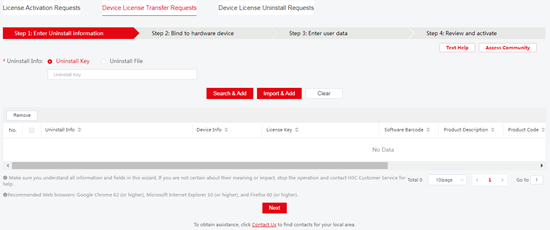
3. As shown in Figure 41, select Uninstall Key and upload Uninstall keys. For information about obtaining Uninstall keys, see "Obtaining an Uninstall key on the source device." To upload Uninstall keys, use one of the following methods:
¡ To upload Uninstall keys one by one:
# Enter or copy and paste a complete Uninstall key in the empty Uninstall Key box as shown in Figure 41, and then click Search & Add. The platform will automatically obtain the information associated with the Uninstall key.
# Repeat this step to add multiple Uninstall keys.
Figure 41 Uploading Uninstall keys
¡ To upload Uninstall keys in bulk.
# As shown in Figure 41, click Import & Add.
# In the dialog box that opens, click the Download Excel Uninstall Key Import Template link to download the Excel Uninstall key import template, as shown in Figure 42.
# Enter Uninstall keys in the template, save the template, and then upload it to the platform. The Uninstall keys in the template are all imported to the platform.
4. Select entries to uninstall, and then click Next.
Figure 43 Finishing adding Uninstall files
Binding license keys to the destination device
1. Review the Uninstall keys on the Bind to hardware device page.
To remove an Uninstall key, select that Uninstall key and click Remove.
Figure 44 Bind to hardware device page
2. Bind the uninstallation information of the source device to the destination device. Make sure you understand the impact of the binding operation, and then select the option that explicitly states so.
3. Click Next. For more information, see "Binding license keys to devices."
Figure 45 Finishing binding license keys to devices
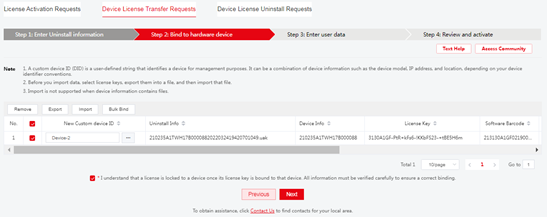
Entering user information
Enter user information, and then click Next. For more information, see "Specifying user information_Ref73361035."
Reviewing information and activating the licenses
Review and activate the license to obtain a new activation file. For more information, see "Reviewing information and activating the licenses."
Figure 46 Succeeding in requesting license transfer

Installing the new activation file on the destination device
|
CAUTION: Before you install an activation file, back up and keep your activation file safe. If the activation file is deleted or the license is unavailable because of device failure, you can use the backup activation file to restore the license. |
Log in to the destination device and install the new activation file on the destination device. For more information, see "Installing an activation file on the device."
Uninstalling a license
About this task
A license key is bound to a device once you activate the license key on H3C License Management Platform. You cannot bind this license key to another device. To unbind a license key for a license that has not expired from a device, obtain the Uninstall key for the license on the device. Then, request for license uninstallation on H3C License Management Platform.
After license uninstallation is requested successfully, you can use this license key to request a new activation file on H3C License Management Platform.
The new activation file can be installed on another device for license transfer or on the local device for license restoration.
For support of license uninstallation, see the license compatibility information for the product.
License uninstallation workflow
Figure 47 Uninstallation workflow
Restrictions and guidelines
You can uninstall only formal licenses that have not expired.
Obtaining an Uninstall key for a license on the device
Log in to the device to obtain an Uninstall key for a license. For more information, see "Obtaining an Uninstall key on the source device."
Requesting license uninstallation on H3C License Management Platform
|
CAUTION: If you cannot obtain an Uninstall key because of device failure, contact H3C Support to unbind the device from the license. |
To request license uninstallation on H3C License Management Platform:
1. Log in to H3C License Management Platform at https://new-licensing.h3c.com/website/anonymous/navIndex/en-US/activate/input-license. Click the Device License Uninstall Requests tab.
To ensure your asset security, prevent licenses from being uninstalled anonymously by unauthorized users, and facilitate license uninstallation tracing, you must log in to the H3C official website before you are placed on the Device License Uninstall Requests page.
|
|
NOTE: After you log in to the H3C official website, complete license uninstallation as soon as possible. If you have not uninstalled a license for a long time (currently, 4 hours), you will be requested to re-log in to the H3C official website. After you re-log in to the H3C official website, the page will be automatically returned to the first step of the Device License Uninstall Requests page. |
Figure 48 Device License Uninstall Requests page
2. Use one of the following methods to enter uninstallation information:
¡ Manually enter Uninstall keys one by one and click Search & Add to obtain uninstallation information.
¡ Import Uninstall keys in bulk. First, click Import & Add and download the Excel Uninstall key import template. Then, enter Uninstall keys in the template and upload the Excel file back to H3C License Management Platform to obtain uninstallation information.
For information about obtaining Uninstall keys, see "Obtaining an Uninstall key on the source device."
3. Select the uninstallation information that will be uninstalled.
4. Click Next.
5. Enter user information, and then click Next. For more information, see "Specifying user information_Ref73361035."
6. Review the uninstallation information, and then select the option that explicitly states your acceptance of all terms in the legal statement.
7. Click Confirm & Uninstall.
8. Review license and device information, and then click OK. The binding between the device and license key will be removed.
Appendix A License sharing
Overview
WLAN AP license sharing technology is introduced. It allows ACs to share AP licenses with the ACs without any AP licenses installed. This technology also achieves centralized management of licenses and efficient use of license resources.
WLAN AP license sharing technology functions in different networks to implement different purposes.
· WLAN IRF license sharing.
· WLAN AP license synchronization between ACs.
· License sharing in distributed unified wireless AC (UWAC) deployment.
WLAN IRF license sharing
The WLAN IRF technology virtualizes multiple physical devices into one virtual fabric. AP licenses installed on member devices are shared across the IRF fabric.
The maximum number of concurrent online APs in the entire IRF fabric cannot exceed the following limits:
· The sum of AP count allowed by all licenses on member devices.
· The upper limit on the AP count supported by the connected device.
As shown in Figure 49, AC 1 has L1 licenses installed, allowing L1 concurrent online APs. AC 2 has L2 licenses installed, allowing L2 concurrent online APs.
· After an IRF fabric is formed, it has a total of L1 + L2 licenses, allowing L1 + L2 concurrent online APs.
· If a member device is faulty or leaves the IRF fabric, its licenses continue to function for a 30-day grace period in the IRF fabric to ensure service continuity.
· After the grace period, the licenses on the leaving member device are no longer available. The license capacity reduces to the sum of the remaining licenses in the fabric. The license capacity change will not bring the existing online APs offline even if the number of existing online APs exceeds the license limit. The new limit takes effect after the number of existing online APs goes below the limit.
Figure 49 WLAN IRF license sharing
WLAN AP license synchronization between ACs
In this solution, each AC manages their own APs independently. You can configure the AP license synchronization feature on the ACs that can reach each other.
According to the number of ACs configured with the AP license synchronization feature, WLAN license sharing functions in the following modes: dual-AC mode and N+1 mode (N≥2).
Dual-AC mode
When two ACs are configured with the license synchronization feature, they work in the dual-AC mode. In this mode, the number of licenses is accumulated.
The maximum number of concurrent APs associated with an AC cannot exceed the following limits:
· The sum of AP count allowed by all licenses on the two ACs.
· The upper limit on the AP count supported by the connected AC.
As shown in Figure 50, AC 1 has L1 licenses installed, allowing L1 concurrent online APs. AC 2 has L2 licenses installed, allowing L2 concurrent online APs.
· After configuring AP license synchronization, each AC has L1 + L2 licenses, allowing L1 + L2 concurrent online APs.
· If an AC is faulty, its licenses continue to function for a 30-day grace period to ensure service continuity.
· After the grace period, the licenses on the leaving AC are no longer available. The license capacity reduces to the number allowed by the licenses on the remaining AC. The license capacity change will not bring the existing online APs offline even if the number of existing online APs exceeds the license limit. The new limit takes effect after the number of existing online APs goes below the limit.
Figure 50 License sharing in dual-AC mode
|
|
NOTE: 1+1 backup is a typical example of dual-AC mode. In this mode, licenses are installed on only the master AC. After configuring AP license synchronization, the master AC synchronizes its licenses to the backup AC. When the master AC fails, the backup AC will take over the service, and APs will be reassociated with the backup AC. |
N+1 mode
When more than two ACs are configured with the license synchronization feature, they work in the N+1 (N≥2) mode.
In this mode, N master ACs are configured, and one AC acts as the backup AC. The master ACs do not share their licenses with each other. They only synchronize their licenses to the backup AC. In this case, the license capacity on the ACs varies:
· Each master AC allows the number of APs that are licensed by its own licenses.
· The backup AC allows the accumulated number of licensed APs allowed on all master ACs.
In addition, the maximum number of concurrent APs associated with an AC cannot exceed the upper limit supported by the AC.
When a master AC fails, the APs associated with to the AC switch to the backup AC. When the faulty AC recovers, the APs are reassociated with the recovered AC.
As shown in Figure 51, AC 1 through AC n act as master ACs, and AC n+1 acts as the backup AC. AC 1 has L1 licenses installed, allowing L1 concurrent online APs. AC n has Ln licenses installed, allowing Ln concurrent online APs. No licenses are installed on the backup AC.
· After configuring AP license synchronization on the ACs, the license capacity on the backup AC equals the accumulated number of licenses on the master ACs. The license capacity on each master AC remains unchanged.
· If a master AC is faulty, its licenses continue to function for a 30-day grace period to ensure service continuity. The APs associated with the AC switch to the backup AC.
· After the grace period, the licenses on the leaving AC are no longer available. The license capacity on the backup AC reduces to the number of the licenses on the remaining master ACs. The license capacity change will not bring the existing online APs offline even if the number of existing online APs exceeds the license limit. The new limit takes effect after the number of existing online APs goes below the limit.
Figure 51 License sharing in N+1 mode
Distributed UWAC deployment license sharing
The unified wireless AC (UWAC) technology enables a switch to support the WLAN function through a unified wired-wireless AC feature pack installed on the switch. The unified wired-wireless AC feature pack is installed on the MPU of a modular switch or on a fixed-port switch.
Switches in distributed UWAC deployment operate in the following modes: dual-MPU mode or IRF mode. The unified wired-wireless AC feature packs are installed on both master and backup devices. All WLAN packets received by the master and backup devices are sent to the master device and only one unified AC provides WLAN access service at a time.
The license sharing in a distributed UWAC network functions similarly as the license sharing in a WLAN IRF network.
In dual-MPU mode
Typically, a high-end modular switch uses two MPUs. After installing unified wired-wireless AC feature packs on two MPUs, AC functionality is enabled and the standby MPU functions as a backup AC.
As shown in Figure 52, the master MPU has L1 licenses, allowing L1 concurrent online APs. The standby MPU has L2 licenses installed, not allowing any APs to access.
· With license sharing enabled, each MPU has L1 + L2 licenses, but only the master MPU allows L1 + L2 concurrent online APs.
· If the master MPU is faulty, the backup MPU takes over the services. The master MPU's licenses continue to function for a 30-day grace period to ensure service continuity.
· After the grace period, the licenses on the leaving MPU are no longer available. The license capacity reduces to the licenses on the remaining MPU. The license capacity change will not bring the existing online APs offline even if the number of existing online APs exceeds the license limit. The new limit takes effect after the number of existing online APs goes below the limit.
Figure 52 Dual-MPU mode license sharing
|
|
NOTE: In a live network, the standby MPU has no licenses installed, and it uses the licenses shared by the master MPU. |
In IRF mode
As shown in Figure 53, multiple switches form an IRF fabric. The unified wired-wireless AC feature pack is installed on each IRF member device and each IRF standby device functions as a backup AC.
· The master switch has L1 licenses installed, allowing L1 concurrent online APs. The standby switch n has Ln licenses installed, not allowing any APs to access.
· After an IRF fabric is formed, the license capacity on each AC equals the accumulated number of licenses on all ACs, but only the master AC allows the access of APs.
· If the master switch is faulty or leaves the IRF fabric, a standby switch becomes the master to provide AP access services. The licenses of the original master device continue to function for a 30-day grace period in the IRF fabric to ensure service continuity.
· After the grace period, the licenses on the leaving member device are no longer available. The license capacity reduces to the sum of the remaining licenses in the fabric. The license capacity change will not bring the existing online APs offline even if the number of existing online APs exceeds the license limit. The new limit takes effect after the number of existing online APs goes below the limit.
Figure 53 IRF mode license sharing
|
|
NOTE: In a live IRF network, standby devices typically have no licenses installed, and they use the licenses shared by the master device. |
Appendix B License configuration examples
CLI
Network configuration
As shown in Figure 54, install AP licenses on the AC for the AC to manage the AP and for the AP to provide wireless services to the client.
Configuring the AC
Obtaining a license key
After you obtain a license key, back up it and keep the backup license key in a safe place for future use.
· Obtain a formal license key: purchase a software license certificate for it. The authorization serial number in the software license certificate is the license key.
· Obtain a trial license key: contact your H3C sales representative or H3C Support.
Identifying the license storage on the device
Execute the display license feature command in any view to identify the free space of the license storage,.
<Sysname> display license feature
Total: 360 Usage: 0
Feature Licensed State
APMGR N -
Compressing the license storage on the device
<Sysname> system-view
[Sysname] license compress
This command will delete all data relevant to uninstalled and expired keys/licenses, including Uninstall keys, and create a new device ID for activation keys/files.Make sure you have saved the Uninstall keys so you can apply for a new activation key/file for the unexpired licenses that were covered by the uninstalled activation keys/files.
Are you sure you want to continue? [Y/N]: Y
This operation might take some time. Do not perform any other operations until the operation is completed or a failure message is displayed. Please wait...Done.
Obtaining device information from the device
# Execute the display license device-id command in any view to obtain the value of the SN and Device DID fields.
<Sysname> display license device-id
SN: 210235A1JMC166XXXXXX
SN CHECK_SUM: 2D0BF254
Device ID: flash:/license/210235A1JMC166XXXXXX.did
Use FTP or TFTP to upload the DID file to the PC.
<Sysname> tftp 192.168.10.22 put flash:/license/210235A1JMC166XXXXXX.did
Press CTRL+C to abort.
% Total % Received % Xferd Average Speed Time Time Time Current
Dload Upload Total Spent Left Speed
100 1029 0 0 100 1029 0 43527 --:--:-- --:--:-- --:--:-- 60529
<Sysname>
Requesting an activation file on H3C License Management Platform
Adding license keys
1. Access H3C License Management Platform at https://new-licensing.h3c.com/website/anonymous/navIndex/en-US/activate/input-license.
Figure 55 Accessing H3C License Management Platform
2. Add license keys:
Figure 56 Adding license keys
3. Select license keys to be activated, and then click Next.
Binding license keys to devices
1. Click the ![]() icon next to the empty Device ID box in
the license key entry. In the dialog box that opens, enter the required device
information, and then click OK.
icon next to the empty Device ID box in
the license key entry. In the dialog box that opens, enter the required device
information, and then click OK.
For information about how to obtain device information, see "Obtaining device information from the device."
Figure 57 Entering device information
2. Review the bindings carefully. Make sure you understand the impact of the binding operation, and then select the option that explicitly states so.
Figure 58 Reviewing the bindings
3. Click Next.
Specifying customer information
Enter customer information and then click Next.
Figure 59 Customer information
Reviewing information and activating the licenses
1. Review the license key and device information and then select I accept all terms of H3C Legal Statement.
2. Click Confirm & Activate.
Figure 60 Confirming and activating the licenses
3. Double-check the license key and device information, and then click OK.
Figure 61 Confirming information
4. Click Get Activation Info to download an activation key or activation file to the local disk.
Figure 62 Obtaining activation information
Installing an activation file on the device
|
CAUTION: Back up an activation file before you install it. If the activation file is inadvertently deleted or becomes unavailable for some other reason, you can use the backup activation file to restore the license. |
# Use FTP or TFTP to upload the activation file to be installed to the device.
<Sysname> tftp 192.168.10.22 get 210235A1JMC166XXXXXX1909581318505.ak
Press CTRL+C to abort.
% Total % Received % Xferd Average Speed Time Time Time Current
Dload Upload Total Spent Left Speed
100 2594 100 2594 0 0 42681 0 --:--:-- --:--:-- --:--:-- 48943
Writing file...Done.
# Install the activation file.
<Sysname> system-view
[Sysname] license activation-file install flash:/210235A1JMC166XXXXXX1909581318505.ak
This operation might take some time. Do not perform any other operations until this operation is completed. Please wait...Done.
[Sysname]
Viewing license information
# Execute the display license command on the AC to display detailed information about licenses.
[Sysname] display license
flash:/license/210235A1JMC166XXXXXX1909581318505.ak
Feature: APMGR
Product Description: Enhanced Access Controller License,8 APs,for Verticals,for V7
Registered at: 2021-05-19 17:29:14
License Type: Trial (days restricted)
Trial Time Left (days): 180
Current State: In use
Pre-installed License
Feature: APMGR
Feature Description: PreAtom This is APMGR license
Time Left (days): 0
Current State: Expired
[Sysname]
Web interface
Network configuration
As shown in Figure 63, install AP licenses on the AC for the AC to manage the AP and for the AP to provide wireless services to the client.
Configuring the AC
Obtaining a license key
After you obtain a license key, back up it and keep the backup license key in a safe place for future use.
· Obtain a formal license key: purchase a software license certificate for it. The authorization serial number in the software license certificate is the license key.
· Obtain a trial license key: contact your H3C sales representative or H3C Support.
Identifying the license storage on the device
1. Click the system view tab at the bottom of the page.
2. From the left navigation pane, select System > License Management, .
3. Click the Compress tab to identify the license storage.
4. If the license storage is insufficient, click Compress, and then click OK in the dialog box that opens.
Figure 64 Identifying the license storage
Obtaining device information from the device
1. Click the system view tab at the bottom of the page.
2. From the left navigation pane, select System > License Management, click the Obtain DID tab, and then click Export DID.
Figure 65 Obtaining device information
Requesting an activation file on H3C License Management Platform
Adding license keys
1. Access H3C License Management Platform at https://new-licensing.h3c.com/website/anonymous/navIndex/en-US/activate/input-license.
Figure 66 Accessing H3C License Management Platform
2. Add license keys:
Figure 67 Adding license keys
3. Select license keys to be activated, and then click Next.
Binding license keys to devices
1. Click the ![]() icon next to the empty Device ID box in
the license key entry. In the dialog box that opens, enter the required device
information, and then click OK.
icon next to the empty Device ID box in
the license key entry. In the dialog box that opens, enter the required device
information, and then click OK.
For information about how to obtain device information, see "Obtaining device information from the device."
Figure 68 Entering device information
2. Review the bindings carefully. Make sure you understand the impact of the binding operation, and then select the option that explicitly states so.
Figure 69 Reviewing the bindings
3. Click Next.
Specifying customer information
Enter customer information and then click Next.
Figure 70 Customer information
Reviewing information and activating the licenses
1. Review the license key and device information and then select I accept all terms of H3C Legal Statement.
2. Click Confirm & Activate.
Figure 71 Confirming and activating the licenses
3. Double-check the license key and device information, and then click OK.
Figure 72 Confirming information
4. Click Get Activation Info to download an activation key or activation file to the local disk.
Figure 73 Obtaining activation information
Installing an activation file on the device
|
CAUTION: Back up an activation file before you install it. If the activation file is inadvertently deleted or becomes unavailable for some other reason, you can use the backup activation file to restore the license. |
To install an activation file on the device:
1. Click the system view tab at the bottom of the page.
2. From the left navigation pane, select System > License Management.
3. On the License configuration tab,
click the ![]() icon.
icon.
4. In the dialog box that opens, click Select File, select a file, and then click Apply.
Figure 74 Installing an activation file
Viewing license information
1. Click the system view tab at the bottom of the page.
2. From the left navigation pane, select System > License Management. On the License configuration page, you can view license information.
Figure 75 Viewing license information
Appendix C FAQ
License activation
Q: What is a license key and what is an activation file?
A: A license key uniquely identifies a license. An activation file uniquely binds a license key to a device. To use a license-based feature on a device, you must install the activation file for that license on the device.
· To obtain a license key, purchase a software license certificate from an H3C approved sales channel.
· To obtain an activation file, access H3C License Management Platform at https://new-licensing.h3c.com/website/anonymous/navIndex/en-US/activate/input-license. Then, request an activation file based on the license key and hardware information of the target device.
Q: Can I modify the system time of the device after a license is installed?
A: For a permanent license or a days-restricted license, modifying the system time does not affect the license validity period.
Q: Might the DID file for the device change? What impact does a DID file change have?
A: The DID file would change if you compress the license storage area by using the license compress command.
The DID file change does not affect the activated licenses on the device. However, you will be unable to install the activation files obtained by using the old DID on the device. To resolve the issue, contact H3C Support.
To obtain a new activation file, you must export the new DID file from the device.
Q: Do I need to purchase and install new licenses for licensed features on the device after a software upgrade?
A: No, you do not need to do this. Unexpired licenses will continue to take effect after the device software upgrades.
Q: Will activated license activation files be lost after the device reboots or the device software upgrades?
A: No, they will not.
License uninstallation
Q: Can I uninstall an expired license?
A: No, you cannot. To delete expired licenses, execute the license compress command.
Q: How do I obtain the Uninstall key for a license?
A: Execute the display license command, identify the activation key for the feature license, and examine the Uninstall Key field for its Uninstall key. The value for this field depends on the device model.
Figure 76 Sample output from the display license command
Q: Can I install an uninstalled activation file on the device again?
A: No. An activation file will become invalid after you uninstall it. To restore the license, use one of the following methods:
· License transfer—On H3C License Management Platform, use the Uninstall key to transfer the license to the device again and obtain a new activation file. Then, install the new activation file on the device.
· License uninstallation and reactivation—Perform the following operations:
a. On H3C License Management Platform, use the Uninstall key to request license uninstallation, which unbinds the device and the license key.
b. Use the license key and device information to request a new activation file.
c. Install the new activation file on the device.
Support for license transfer and uninstallation depends on the device model. For more information, see the license matrixes document for that product..
Q: How do I delete expired and uninstalled licenses?
A: Execute the license compress command. This operation will change the DID or DID file.
As a best practice, perform the following tasks before you compress the license storage:
· Back up the Uninstall keys of uninstalled licenses for subsequent license transfer or license uninstallation.
· Install all idle activation files registered with the old DID.
Q: What should I do if I inadvertently delete the activation file for a license?
A: After you delete the activation file for a license, you will be unable to use the licensed feature or uninstall its license for file transfer.
To resolve the issue:
1. Execute the copy command to copy the backup activation file to the license folder in the root directory of the storage medium on the device, for example, flash:/license.
2. Reboot the device. Then, the licensed-feature continues to take effect and you can uninstall the license if needed.
License retrieval
Q: How do I retrieve a lost license key?
A: If you lose the license key before obtaining an activation file, contact H3C Support to retrieve the license key based on the license purchase contract.
If you lose the license key after obtaining an activation file, contact H3C Support and provide the activation file or the device information.
Q: How do I retrieve an activation file?
A: You will be unable to use a licensed feature if its activation file is lost or inadvertently deleted. To retrieve an activation file, use one of the following methods:
· Use the backup activation file.
· Find the activation file from the email box of the applicant.
· Contact H3C Support and provide the license key or device information to retrieve the activation file.
Q: How do I transfer licenses when a node fails or when license transfer is required?
A: Contact H3C Support for help.

